Vietnam War
Vietnam War
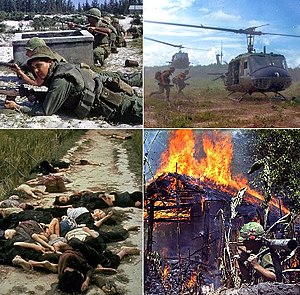
Total casualties: 2-5.1 million Vietnamese, of whom 1.3 million were soldiers; 63,500 soldiers of other nations.
Battles and operations of the
Vietnam War
Battle of Tua Hai (1960) - Battle of Ap Bac (1963) - Battle of Nam Dong (1964) - Tonkin Incident (1964) - Operation Flaming Dart (1965) - Operation Rolling Thunder (1965-68) - Battle of Dong Xoai (1965) - Battle of the Ia-Drang-.Valley (1965) - Operation Crimp (1966) - Operation Hastings (1966) - Battle of Long Tan (1966) - Operation Attleboro (1966) - Operation Cedar Falls (1967) - Battle of Hill 881 (1967) - Battle of Dak To (1967) - Battle of Khe Sanh (1968) - Tet-Offensive (1968) - Battle of Huế (1968) - Operation Speedy Express (1968/69) - Operation Dewey Canyon (1969) - Battle of Hamburger Hill (1969) - Operation MENU (1969/70) - Operation Lam Son 719 (1971) - Battle of FSB Mary Ann (1971) - Battle of Quảng Trị (1972) - Operation Linebacker (1972) - Operation Linebacker II (1972) - Battle of Xuan Loc (1975) - Operation Frequent Wind (1975).
The Vietnam War (Vietnamese Chiến tranh Việt Nam; also Kháng chiến chống Mỹ "Vietnam War against USA") was fought in and around Vietnam from about 1955 to 1975. North Vietnam and the National Front for the Liberation of South Vietnam (National Liberation Front, abbreviated NLF), also known as the "Viet Cong," opposed the United States and South Vietnam as the main warring parties. Since the conflict immediately followed the Indochina War (1946-1954) between the colonial power France and the Vietnamese independence movement of the Việt Minh and extended to all of Indochina, it is also called the Second Indochina War. Because of the superpowers directly and indirectly involved, it is considered a proxy conflict in the Cold War. It ended with the victory of North Vietnam and the first military defeat of the USA in its history.
After the partition of Vietnam in 1954, political reprisals and deceived free elections by the South Vietnamese Prime Minister Ngô Đình Diệm, a civil war broke out from 1955 to 1964: The Việt Minh, which gave rise to the NLF in 1960, wanted to overthrow the country's anti-communist government and reunite it with the North. In this effort, the NLF was supported by communist-ruled North Vietnam under Hồ Chí Minh and Lê Duẩn, while South Vietnam was increasingly supported by the United States. Successive U.S. administrations under Presidents Eisenhower, Kennedy, Johnson, and Nixon feared, based on the so-called domino theory, that with Vietnam, all of Southeast Asia could come under the control of communist governments.
After the so-called Tonkin Incident of 1964, President Lyndon B. Johnson ordered direct bombing of North Vietnam for the first time in February 1965. Beginning in March, he sent increasing numbers of ground troops to fight the NLF in South Vietnam. As a result, the Soviet Union and the People's Republic of China supported North Vietnam. Six countries participated in the conflict on the side of the United States and South Vietnam with their own contingents of troops. From 1964, fighting also spread to Laos, and from 1970 to Cambodia. After the NLF's Tet Offensive, Johnson halted bombing by November 1968. His successor, Richard Nixon, gradually withdrew U.S. troops from South Vietnam beginning in 1969, but at the same time extended the war to Cambodia. After a renewed bombing campaign with no military results, his administration concluded a cease-fire with North Vietnam in January 1973. By March 29 of that year, all U.S. troops withdrew, and North Vietnam released all American prisoners of war. On May 1, 1975, the war ended with the capture of the South Vietnamese capital of Saigon by North Vietnamese troops.
It is estimated that Vietnamese war casualties ranged from at least two million to over five million, including over 1.3 million soldiers. In addition, 58,220 U.S. soldiers and 5,264 soldiers of their allies fell. Several million Vietnamese were maimed and exposed to the highly toxic defoliant Agent Orange.
Previous story
Indochina War
→ Main article: Indochina war and history of Vietnam
The Vietnamese nationalist Hồ Chí Minh had proposed an independent, unified and democratic Vietnam at the VersaillesPeace Conference in 1919 in accordance with the principles of U.S. President Woodrow Wilson's 14-point program. Wilson had rejected this. Ho became a follower of Lenin's theory of imperialism in 1920, according to which capitalism had entered a final stage worldwide and its rule was most likely to be broken and overcome in the long term by popular uprisings in industrially underdeveloped countries. Ho wanted to realize this theory in Vietnam independently of Soviet or Chinese dominance.
Vietnam had been under French colonial rule since 1858. In June 1940, Nazi-ruled Germany defeated France in the Western campaign. From July 1940, during the Second World War, Vietnam was under the French Vichy regime, which was tolerated by the Nazi regime. This allowed the Empire of Japan, which was allied with Nazi Germany, to occupy Vietnam with Japanese troops from July 1940. In 1941, Ho Chi Minh formed a coalition of anti-colonialist, nationalist and communist groups, the Viet Minh. They fought with initially about 5000 men against the occupiers and for Vietnam's independence. Since March 1945, the USA supported the Viet Minh militarily and logistically. They took advantage of Japan's surrender on August 15, 1945, to launch the August Revolution. Afterwards, they had competing nationalists, Trotskyists, supporters or partners of French and religious sects arrested as "traitors to the fatherland," tortured in many cases and murdered by "killing committees." On September 2, 1945, Ho proclaimed the independent Democratic Republic of Vietnam (DRV) and became its president.
France, which under Charles de Gaulle wanted to regain its former colonies in Indochina, occupied South Vietnam until the end of 1945 and agreed with Ho in March 1946 on a transitional arrangement limited to five years. The French attack on HảiPhòng (November 1946) triggered the Viet Minh's Indochina War against France, fought as an anti-colonial guerrilla war. To obtain further U.S. financial aid for its colonial forces, France promoted an anti-communist nationalism in Vietnam. To this end, in 1949 it agreed with former Emperor BảoĐại on an independent, unified "State of Vietnam" (SOV) within the framework of the overseas Union française, designated him as head of state, and committed to building a national army and state administration. When Bao Dai realized that he was to be an influence-less representative of a puppet state controlled by France, he left Saigon for France.
During the Indochina War, the Communist Party of Vietnam instituted a Chinese-style agrarian reform in which up to 50,000 peasants and Viet Minh of the older generation, who were seen as corrupted by the French colonizers, were murdered.
After the defeat of French troops at the Battle of Điện Biên Phủ, at the Indochina Conference in Geneva (May 8-July 21, 1954), warring adversaries and major powers involved agreed to an immediate cease-fire, mutual troop withdrawal, a demilitarized buffer zone along the 17th parallel, and nationwide, internationally supervised democratic elections of the future government for 1956. Latitude, and nationwide, internationally supervised democratic elections of the future government for 1956. Cambodia, Laos, and both parts of Vietnam were to become independent and not belong to any military alliance. The Soviet Union and the People's Republic of China thus followed U.S. demands to prevent their further involvement in Indochina. The Viet Minh signed the agreement with them, as well as with France and Great Britain, because they expected Ho's electoral victory. The U.S. and Bao Dai rejected it, despite the concession, so as not to encourage unification of all Vietnam under communist rule. However, the U.S. pledged not to use threats and force to change the decisions. French colonial troops withdrew to South Vietnam by October 1954, leaving Hanoi to the Viet Minh. Of 100,000 South Vietnamese Viet Minh, about 90,000 moved to North Vietnam, and the remainder stayed in South Vietnam as Hos cadres for the 1956 elections. The decisions of the Indochina Conference, the cease-fire, troop withdrawal, resettlement, and elections were to be monitored by the International Control Commission an observation mission consisting of Polish, Canadian, and Indian troops.
Indochina Policy of the Great Powers
After World War II, the Soviet Union under Josef Stalin was interested in good relations with its wartime ally France and therefore did not officially support Ho's independence drive, but contributed to the Viet Minh's victory in the Indochina War by supplying arms. However, at the Indochina Conference, Soviet Foreign Minister Vyacheslav Mikhailovich Molotov forced the Viet Minh to agree to withdraw from South Vietnam. Until 1950, the Soviet Union did not recognize the DRV.
The People's Republic of China, founded in 1949, had supported the Viet Minh's struggle for independence with weapons captured in its own civil war and training camps along the border with North Vietnam, and recognized the DRV in 1950. At the Indochina Conference, however, it advocated the temporary partition of the country and a two-year period until national elections could be held.
The U.S. had treated Ho as an ally until Japan's surrender (September 2, 1945). The Office of Strategic Services continued to help the Viet Minh thereafter. U.S. President Franklin D. Roosevelt supported the right of peoples to self-determination and wanted to free Indochina from European colonial rule and Japanese occupation, placing it under international trusteeship to that end and involving China. De Gaulle headed the Provisional Government of the French Republic in October 1944. But after Japan stripped the French colonial forces still under the Vichy regime in Indochina on March 9, 1945, the European Allies urged Roosevelt to involve France in the fight against Japan. Whether he dropped his trusteeship plan before his death on April 12, 1945, and allowed France to recolonize Indochina is disputed.
His successor, Harry S. Truman, knew little of Roosevelt's postwar plans and dropped Indochina's decolonization. In May 1945, he recognized France's sovereignty over Indochina. At the Potsdam Conference in July 1945, he agreed with the other Allies to partition Vietnam and extend South East Asia Command (SEAC: the Allied force command in Southeast Asia) to the 16th parallel. National China under Chiang Kai-shek occupied the northern, Britain and France occupied the southern part of Vietnam with Saigon until September 1945. The U.S. Navy helped them transport new troops from Europe to South Vietnam.
Since 1947, Truman had pursued the Containment Policy, which was intended to contain Communist expansion worldwide by all available means. After Mao Zedong's victory over the National Chinese in 1949, Joseph McCarthy accused Truman of having caused China's "loss" to the Communists. Partly because of this domestic pressure, Truman wanted to halt the Viet Minh advance. That is why, starting in February 1950 (Security Memorandum 142), he militarily supported Bao Dai's puppet regime and thus France's colonial rule. In the process, the U.S. also pursued economic interests: The Indochina market as well as Vietnam's export products tin, rubber and rice were to remain available for anti-communist states in Southeast Asia, including defeated Japan.
At the start of the Korean War in June 1950, Truman simultaneously dispatched U.S. military forces to South Korea and Indochina to weaken the People's Republic of China and enlist France in building the European Defense Community in Western Europe against the Eastern Bloc. Ho was now seen in the United States as a tool of the Soviet and Chinese Communists to conquer all of Southeast Asia. When the Soviet Union and the People's Republic of China recognized the DRV in 1950, the U.S. in return recognized the SOV as the only legitimate state of Vietnam and pledged to provide financial security for France's Indochina War and Bao Dai's regime. To this end, they concluded a military assistance treaty with South Vietnam on December 23, 1950, and a treaty on economic and technological assistance on September 7, 1951. In addition, a U.S. representative office was established in Saigon.
Beginning in 1952, Truman advocated the domino theory, according to which communism would ideologically inevitably strive for world domination, so that a communist regime would cause a chain reaction in its neighboring states that would ultimately threaten the United States. The metaphor of falling dominoes was intended to link complex events in distant regions to U.S. national security. All five U.S. administrations involved in the Vietnam War espoused the domino theory and a containment policy, despite internal nuances. Truman declared Indochina a key region. If a country there fell under communist control, all of Southeast Asia and the Middle East would follow. This would threaten the security of Western Europe and U.S. interests in the Far East. Therefore, a Viet Minh victory in Indochina would have to be prevented at all costs. Prospects for success and follow-up costs of U.S. involvement were not questioned.
From 1952 to 1954, the United States increased its financial and military aid to France to $2.76 billion, or from 40% to 80% of the total cost of the Indochina War.
Dwight D. Eisenhower, U.S. president from January 1953 to January 1961, advocated a rollback policy and, also on the advice of his secretary of state, John Foster Dulles, gave very great weight to defense against communist expansion in Indochina. In early 1954, without the approval of the U.S. Congress, he sent ten B-26 bombers and 200 U.S. troops for the first time, and in March he also sent aircraft to drop napalm into South Vietnam to support France's fight against the Viet Minh. At the same time, he called for a U.S. supreme command of all future French anticolonial military action in Indochina to give himself room to maneuver after France's looming defeat. He resisted the demand of the United Chiefs of Staff and the National Security Council to use nuclear weapons against the Viet Minh to decide the Battle of Dien Bien Phu.
After France's defeat, the U.S. government secured the formation of SEATO in September 1954-with Australia, France, Britain, New Zealand, Pakistan, the Philippines, and Thailand-which provided for mutual consultation and, if necessary, joint military intervention in the event of "armed aggression" against a signatory state. Laos, Cambodia, and South Vietnam were not Alliance members but were defined in an additional protocol as areas where armed aggression would be considered a hostile act directed against the interests of the signatories. However, the forms and circumstances of aggression relevant to the treaty and members' responses to it were not precisely defined. The ambiguous treaty served the United States well in providing international authority for subsequent military actions in Indochina.
From 1960, the People's Republic of China supported North Vietnam and the then newly founded NLF with weapons, military advisors and construction teams. From 1965, the Soviet Union did the same, with the same means.
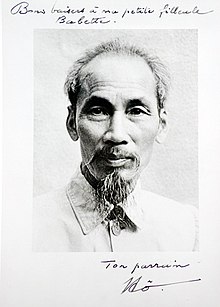
Hồ Chí Minh, 1946
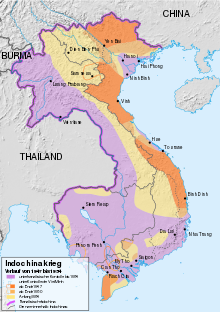
Course of the Indochina War
History
Diem's dictatorship in South Vietnam
Head of State Bao Dai appointed the Catholic Ngô Đình Diệm as prime minister of South Vietnam on July 7, 1954. About one million mostly Roman Catholic North Vietnamese resettled in South Vietnam the following year, aided by U.S. Navy ships. The CIA encouraged the mass exodus with anti-communist propaganda to gain Diem's backing. 90% of the South Vietnamese were Buddhists, traditionally tolerant of non-Buddhists. However, Diem favored Catholics from the north in the allocation of posts for state offices and treated Buddhism not as a religion but as an association. In this way, he generated lasting antipathy toward his followers among the rural population.
Diem faced insubordinate parts of the military and strong private armies of the Cao Dai and Hoa Hao sects as well as the mafia-like Bình Xuyên in Saigon. Only with the help of the CIA, U.S. officer Edward Lansdale, and U.S. special envoy J. Lawton Collins was he able to thwart coup attempts. Collins, whom U.S. President Eisenhower had vested with all powers, ensured in 1955 that South Vietnamese instead of French officers were allowed to lead Diem's newly established "Army of the Republic of Vietnam" (ARVN). Diem, however, rejected any cooperation with other South Vietnamese anti-communist forces and began cracking down on sectarian agents in February 1955. When he provoked a civil war in Saigon by doing so, Collins strongly recommended that the U.S. government drop him. Diem forestalled this by using the ARVN victoriously, albeit at great sacrifice, against the Binh Xuyen in the "Battle for Saigon" from April 27 to May 2, 1955. In concert with U.S. Secretary of State Dulles and a Senate majority led by Senator Mike Mansfield, Eisenhower then decided to unconditionally prop up Diem's regime.
Diem received generous U.S. funding from then on, largely to build up the ARVN along the lines of the U.S. Army. He invested only minimal portions of U.S. aid for social and economic policy. South Vietnam's economy became increasingly dependent on U.S. imports. The urban upper and middle classes profited from cheaper consumer goods from the United States. The development of its own industry was neglected. Diem militarized public order and structured his armed forces in such a way that no independent centers of power were to emerge. This decisively reduced their clout. Diem and his family clan were regarded by the vast majority of South Vietnamese as unscrupulous, corrupt puppets of the West because of his dictatorial domestic policies. This increased the chances of Ho's victory in the all-Vietnamese elections scheduled for 1956. Therefore, Diem canceled them, breaking the 1954 Geneva Accord, but justified this by saying that South Vietnam had not signed it. U.S. President Eisenhower supported him in this. Instead, he deposed Bao Dai in October 1955 and had himself confirmed as the new president in a referendum whose result (98.2%) was rigged, and proclaimed the Republic of Vietnam. In March 1956, a parliament filled with his supporters approved the constitution he had drafted for the Republic of Vietnam, which did not provide for a genuine separation of powers. Vietnam was thus divided into two states, both of which considered themselves the rightful representative for all of Vietnam.
Civil war
Beginning in 1955, Diem resettled villagers from the hill tribes (Montagnards) living in the central highlands, confiscated their land and handed it over to some 210,000 mostly Catholic followers to create a social bulwark against Viet Minh infiltration. He also favored relatives and followers in leadership positions. In doing so, he destroyed thousands of years of village self-government. As a result, the Montagnards formed their own organization, which expanded into the Bajaraka in 1958, demanding autonomy for their settlement areas. Montagnards were recruited from both sides of the civil war that was now beginning.
South Vietnam's armed forces had previously been geared to defending against expected conventional attacks from North Vietnam, but not to fighting insurgents (counterinsurgency). The U.S. now took over their training and equipment. To this end, it initially sent 350 officers to South Vietnam as "military advisors" (trainers, action planners and leaders) and stationed the 77th Special Forces Group there, which was founded in 1953. Thus, for the first time, the U.S. appeared as an independent conflict partner in Vietnam, thus initiating its later entry into the war.
From the summer of 1955 to 1959, Diem's regime carried out the To Cong campaign ("Denounce the Communists!"). In 1955, he closed the border to North Vietnam and cut off postal traffic there. With newly enacted repressive laws, thousands of South Vietnamese were arrested indefinitely or placed under house arrest on mere suspicion of opposing the regime, tortured, and in many cases sentenced to death and shot, including by mobile special courts beginning in 1959. Diem thus reduced the Viet Minh cadre by two-thirds by 1959. He abolished commune elections and appointed thousands of his followers as administrators of South Vietnam's provinces, districts, and villages. In response, the Viet Minh carried out up to 4,000 assassinations of Diem's administrators from 1957 to 1961.
Battles between them and the ARVN began in 1959. Despite increasing popular support for Diem's repressive measures, more and more Viet Minh were killed or imprisoned in South Vietnam. In order not to lose their influence over the South Vietnamese, who were ready to resist, they pressured North Vietnam's government to send in combat troops. The latter had so far given priority to its own social and economic transformation. Beginning in September 1959, it allowed South Vietnamese-born former Viet Minh to return to the South. These transported weapons, food, and other supplies south along a jungle route that later became known as the Ho Chi Minh Trail. In the Battle of Tua Hai in February 1960, the first major battle of the Vietnam War, some 300 Viet Minh captured the headquarters of the ARVN's 32nd Regiment at Tay Ninh (55 km from Saigon) and captured large quantities of supplies there.
North Vietnam's Unity Party, the Lao Dong, developed into a mass party of about 500,000 members in 1960. Its five-year plan of September 1960 called primarily for the development of heavy industry and infrastructure and the collectivization of agriculture. It was led by Premier Phạm Văn Đồng and Party Secretary Lê Duẩn. In response to his call, the Viet Minh united with other opposition groups to form the National Front for the Liberation of South Vietnam (NLF) on December 20, 1960. It was formed at a congress of the outlawed Communist Party of South Vietnam, which had set Diem's overthrow and the expulsion of the U.S. Army as its main goals. Modeled on Mao Zedong's Revolutionary Army, the NLF formed a counter-government of trained cadres who motivated the rural population to revolt and organized armed resistance. In this process, North Vietnam did not appear as an actor because of the 1954 Geneva Accord, but in fact the NLF followed Hanoi's directives. Their opponents equated them with their military branch and called them Viet Cong (VC). The NLF's goal was to force the withdrawal of U.S. military advisors and to form a coalition government of all groups in South Vietnam.
Since North Vietnam wanted to avoid U.S. intervention in the civil war in the south, it supported the NLF only politically, not militarily, until 1961. Until 1965, it remained largely dependent on old French weapons or weapons captured from the ARVN. The NLF saw itself as the engine of a social revolution, mobilized the peasants and introduced procedures in the villages that promoted their self-reliance. Through its redistributive measures, it quickly gained support among the rural population. By the end of 1961, it controlled 75% of South Vietnam's rural areas.
Escalation
With his anti-communist rollback policy, U.S. President John F. Kennedy, in office since January 1961, set the course for the escalation of the Vietnam War. A report by his advisors Walt Rostow and Maxwell Taylor on their visit to Vietnam in early 1961 became decisive: the U.S. would have to commit itself irreversibly to the preservation of South Vietnam and, to this end, strengthen the counterinsurgency strategy. As a result of the Cuban Missile Crisis of 1962, the new Flexible Response strategy was intended to expand U.S. room for maneuver against communist states and insurgencies without risking nuclear war. Therefore, Kennedy ordered some covert military operations against North Vietnam and increased the number of U.S. military advisors in South Vietnam from 400 to 16,575 by 1962. By 1962, the U.S. Air Force was flying 50,000 airstrikes against Vietnamese villages believed to be Viet Cong, including the use of napalm.
In May 1961, Kennedy allowed small, heavily armed secret detachments of South Vietnamese agents, trained by U.S. military advisors, to be dropped into North Vietnam. The necessary flights were organized by the ARVN, disguised as a private airline. Later, pilots from Taiwan were also trained for this purpose. The U.S. population was not to learn of these actions even when they were discovered by North Vietnam. This happened for the first time as early as July 1961; almost all other agents smuggled in were discovered and imprisoned shortly after landing in North Vietnam. Nevertheless, agent teams were increased to several hundred by mid-1964. In the process, cooperation between South Vietnam and Taiwan continued even after Diem's fall.
U.S. Secretary of State Dean Rusk and U.S. Secretary of Defense Robert McNamara justified the increased U.S. deployment in November 1961 on the basis of the SEATO Treaty. Appeasement would lead to Communist victory throughout Indochina, loss of U.S. credibility with Asian allies, and destruction of SEATO. However, Kennedy rejected the call by the Joint Chiefs of Staff, the Defense Department, and Diem for the deployment of regular troops and targeted bombing of Hanoi. Instead, he had funding for the ARVN greatly increased, the elite Green Berets unit sent in, and the Military Assistance Command, Vietnam (MACV) established near Saigon as a high command. He authorized the CIA to conduct sabotage operations in the North. Operation 34A ("OPLAN34") was launched. The CIA's Saigon office thus became an asset whose activities were not adequately monitored by the U.S. Congress.
Between 1959 and 1961, U.S. military advisors trained the Royal Laotian Army and gained recruits from the Hmong tribe in the secret Operation White Star in Laos. Largely because of enormous U.S. arms shipments, including helicopters, armored troop carriers, and modern artillery, the ARVN was militarily successful against the resistance fighters in 1962 and took the strategic and tactical initiative in the civil war.
However, Diem and his brother Ngo Dinh Nhu, the security chief, used the guerrilla defense strategy primarily to intensify the repression of the peasants. To this end, the elaborate Taylor-Staley plan called for concentrating the rural population in "defense villages" beginning in March 1962. Most villagers resisted this because it violated their religious customs and further worsened their already difficult social situation. Except in some highland areas where the CIA carried out the plan, the defense village program was a fatal setback for Diem's regime. In early 1963, in the battle for Ap Bac, a single, relatively poorly armed but determined NLF battalion repulsed attacks by numerically far superior ARVN units. In the process, the incompetence of the South Vietnamese officers became apparent.
In May 1963, Diem's ban on the Buddhist flag in Hue triggered months of severe unrest that gripped all of South Vietnam (Buddhist crisis). Police shot women and children during protest demonstrations. Hunger strikes and self-immolations occurred. In August, Diem's brother Nhu placed the country under martial law. At the same time, he established initial contacts with Hanoi through France's President de Gaulle, without informing the U.S. ambassador.
Kennedy was now faced with the choice of continuing to prop up a corrupt regime rejected in South Vietnam, which increased the NLF's chances of victory by its behavior, or overthrowing Diem and thus interfering with South Vietnam's sovereignty. Only Paul Kattenburg advised in this situation that the U.S. military be withdrawn from South Vietnam and the country left to its own devices, but he was rejected in the National Security Council. Key Kennedy advisors such as Averell Harriman and George Wildman Ball wanted Diem dropped. Kennedy appointed Henry Cabot Lodge, Jr. as the new U.S. ambassador to Saigon. Lodge was to demand that Diem remove Nhu and otherwise encourage disaffected ARVN generals to stage a coup. To increase pressure on Diem, McNamara and Maxwell Taylor recommended to Kennedy the withdrawal of U.S. military advisors and reductions in military aid to the ARVN after their September visit to Saigon. As a result, Kennedy withdrew 1,000 military advisors on October 11, 1963. He planned to withdraw the remainder from Vietnam by 1965. On November 2, 1963, disaffected ARVN officers overthrew Diem and Nhu; both were assassinated after their arrest. Lodge, who had known of the coup plot and had not informed Diem, denied any U.S. involvement upon his return to the United States in June 1964. Several of Kennedy's advisers, including Vice President Lyndon B. Johnson, later viewed the coup as a grave mistake that tied the United States even more closely to South Vietnam.
Entry of the USA into the war
After the fatal assassination of John F. Kennedy on November 22, 1963, Johnson ascended to the presidency. He had always supported the containment policies of his predecessors. On Nov. 26, he endorsed a memorandum written for Kennedy that promised South Vietnam continued aid against any communist aggression. He would not allow "Vietnam to go the same way as China" but would see to it that South Vietnam's generals "put the fear of God into the Communists." In order to secure his domestic policy (Great Society), which was aimed at social balance, in the U.S. Congress, Johnson wanted to protect U.S. interests in Indochina in foreign policy and guarantee the survival of South Vietnam.
Its new ruler, General Dương Văn Minh, a Buddhist, sought a compromise with the NLF against Johnson's wishes and demanded more restraint from the U.S. military. In January 1964, with Johnson's approval, he was overthrown by an officer group led by General Nguyễn Khánh. Other military coups followed; no stable government emerged in South Vietnam until late 1967. North Vietnam took advantage of this situation and sent more fighters and materiel there. With this, the NLF was to first bring the central highlands and the Mekong delta under its control, and then attack in the major cities of South Vietnam as well.
During his March 1964 visit to Vietnam, McNamara found that the NLF controlled 40% of South Vietnam and up to 90% of the areas around Saigon. The ARVN had lost 3,000 troops in the Mekong Delta, a high number of its soldiers deserted, and many did not accept Khánh as commander in chief. Publicly, McNamara nevertheless claimed progress in repelling the NLF. Internally, he recommended increasing military aid and not sending U.S. ground troops before the presidential election (November 1964). These would only further weaken ARVN combat morale and then necessitate more and more U.S. troops (snowball effect). Johnson then stepped up the covert OPLAN34 initiated by Kennedy. This involved the CIA, U.S. Army, and ARVN conducting joint acts of sabotage in North Vietnam to relieve and stabilize the regime in Saigon. In addition, he now had the Defense Department plan in detail the bombing of North Vietnam. He appointed Maxwell Taylor as U.S. ambassador to Saigon, appointed General William Westmoreland as MACV commander in chief, and increased the number of U.S. military advisors in South Vietnam from 16,000 to 23,300 by the end of 1964. At the same time, he offered Hanoi economic aid if it would cease supporting the NLF and recognize the Saigon regime; otherwise, it would face U.S. air strikes (Seaborn mission). In return, Hanoi offered to recognize a neutral South Vietnam if the U.S. withdrew its military there completely. During an attempted mediation by UN Secretary General U Thant in September 1964, both sides insisted on these irreconcilable demands.
Starting in May 1964, Johnson wanted to have his planned war effort authorized by the U.S. Congress in order to involve it, and thus the U.S. population, more closely. The resolution on this was not to be presented until after the presidential election in November because of the lack of a cause for war. During the election campaign, Johnson portrayed his opponent, Barry Goldwater, as a dangerous warmonger who would expand the Vietnam War and plunge the U.S. into a nuclear war with the Soviet Union, and promised not to send ground troops to Vietnam.
On July 31, 1964, a South Vietnamese sabotage squad attacked two North Vietnamese islands as part of "OPLAN34." On August 1, the U.S. warship USS Maddox entered the Gulf of Tonkin to conduct electronic reconnaissance of the North Vietnamese People's Army (NVA). For unexplained reasons, North Vietnam's Coast Guard dispatched three speedboats to the Maddox on August 2. The latter, fearing a torpedo attack, opened fire, sank one of the boats, damaged the others, and reported this "Tonkin incident" to the U.S. government. On August 4, USS Turner Joy (DD-951) mistakenly reported more torpedo attacks during a thunderstorm, but retracted the report. NSA submitted to Johnson only that 10% of radio traffic relevant to the incident that suggested an attack. Johnson ordered initial air strikes on Hanoi that same evening, justifying them on U.S. television as retaliation for "repeated unprovoked acts of violence." The involvement of U.S. warships in sabotage operations was concealed from Congress. Secretary of State George Ball later admitted that they had been dispatched to the Gulf of Tonkin to provoke a cause for war. The immediate retaliatory strikes had been prepared for months.
On August 7, after brief debate, the U.S. Congress passed the Tonkin Resolution with only two votes against (Ernest Gruening, Wayne Morse). This authorized the U.S. government "to take all necessary measures to repel any armed attack on U.S. forces and to prevent further aggression." It was intended to replace a formal declaration of war and served as the U.S. legalization of all subsequent combat operations by its forces in Indochina until its withdrawal in 1970. Johnson achieved a congressional majority for it with the help of Senator William Fulbright and a promise that he did not plan to send ground troops before the election. He silenced Goldwater's criticism that he was "soft on communism" and won a landslide victory in the November 3, 1964, presidential election.
With the targeted and threatened further U.S. air strikes, the U.S. government, as it turned out in 1970, was testing a concept of "coercive diplomacy" developed around 1960 that combined coordinated force and offers of negotiation. The effect was the opposite: the government in Hanoi no longer expected U.S. withdrawal after the collapse of the regime in South Vietnam; rather, it anticipated a U.S. invasion of all of Vietnam and prepared to fight U.S. troops directly in the South as well. Starting in September 1964, it therefore sent armed combat troops to South Vietnam via the Ho Chi Minh Trail and had it further expanded for this purpose.
On November 1, 1964, the NLF directly attacked a U.S. military base for the first time at Biên Hòa. This reinforced Johnson's intention to bomb North Vietnam to weaken the NLF in the south. Initially, the U.S. paid for an increase of 100,000 to 660,000 troops in the ARVN to prop up the regime of General Nguyễn Khánh. In December 1964, the NLF bombed a Saigon hotel where U.S. military advisers were staying and defeated two numerically and weaponry far superior ARVN battalions at Binh Gia. Now Johnson's advisers wanted to bomb North Vietnam earlier to save South Vietnam's regime from collapse.
Allied states
The People's Republic of China was the first state to recognize the NLF in 1960. It saw its role as supporting liberation movements against both superpowers, the Soviet Union and the United States, in Third World countries. After the Tonkin Incident, it declared that it would intervene in North Vietnam in the event of a U.S. invasion. To this end, Mao had troops of 300,000 to 500,000 deployed near China's southern border, built two airfields there, and trained North Vietnamese pilots. In December 1964, the two countries concluded a military aid agreement. In June 1965, the first Chinese aid troops arrived in North Vietnam. Until 1969, the People's Republic of China helped North Vietnam mainly with personnel to repair and maintain roads, railroads and airfields, provided air defense forces and supplied military equipment.
Since the Sino-Soviet rift, the Soviet Union competed for political influence in Indochina with the People's Republic of China, which became a nuclear power in October 1964. On October 14, 1964, Nikita Sergeyevich Khrushchev was overthrown in the Soviet Union. He had pursued peaceful coexistence with the U.S. and therefore supported North Vietnam with some $500 million in economic aid and light weapons, but always refused to supply anti-aircraft guns and anti-tank weapons. After his fall, Hanoi expelled the few Soviet military advisors from the country. His successor, Leonid Ilyich Brezhnev, then agreed with Hanoi on a military aid agreement in February 1965. After the first U.S. bombing of North Vietnam, the Soviet Union took a confrontational course with the United States beginning in November 1964 and condemned all further U.S. bombing. It supplied North Vietnam with S-75 surface-to-air missiles and aircraft, including Mig-21s, and artillery suitable for attacks on U.S. bases. North Vietnam thus received substantial war resources from both countries and successfully played them off against each other in their allocation and in diplomatic support until the end of the war. Ho was more interested in the alliance with the Soviet Union in this regard, while Le Duan was more interested in China. By 1968, the Soviet Union had sent 2,000 military advisers and surpassed China as North Vietnam's main arms supplier. By 1975, it had also granted loans worth some five billion dollars. The People's Republic of China, on the other hand, withdrew its advisers from North Vietnam beginning in 1967 and largely suspended its economic aid during the Cultural Revolution. It resumed it after the Ussuri Incident (March-September 1969) and supplied $500 million worth of goods to North Vietnam in the following years.
North Korea actively supported North Vietnam from 1967 onward with a contingent of fighter pilots, who were mainly used in the defense of Hanoi. As early as 1965, Kim Il-sung had repeatedly stated that North Korea was ready to provide military support to North Vietnam at any time. Fourteen North Korean military personnel died in the fighting, and they are commemorated with a memorial in the Vietnamese community of Tân Dĩnh. It was not until 2001 that the participation of North Korean pilots in the air battles over North Vietnam was officially confirmed by the Vietnamese government.
Beginning in 1965, the GDR called on its citizens to show "international solidarity" with North Vietnam. Donations intended for humanitarian aid were also used for military means. The extent of these, however, is not known. From 1973, the GDR trained 20 to 30 North Vietnamese per year as officers.
Beginning in April 1964, the U.S. government tried to enlist as many countries as possible as supporters of its Vietnam effort ("More Flags" program) to keep it from looking unilateral. By December, 15 states sent mostly symbolic aid contributions. Only SEATO members Australia, New Zealand, the Philippines, Thailand, and South Korea and Taiwan provided significant nonmilitary goods. Johnson then asked the SEATO states for combat troops. Britain declined because it had been protecting the post-colonial federation around Malaysia against Indonesian attacks with 30,000 troops since 1963, including the U.S. military base in Singapore, which the United States needed for its containment policy against the People's Republic of China. The other states sent military only against the U.S. promise to bear all associated costs.
SEATO never officially approved the U.S. deployment. South Korea, not a SEATO member, provided most of the armed forces until 1966, receiving extensive economic, modernization, and military aid in return and contractual commitments from the United States not to reduce its troops in South Korea. Philippine President Ferdinand Marcos received an additional $80 million in economic aid for a nonmilitary relief force, but withdrew it in 1969 in the face of violent civil protests. Thailand allowed the U.S. to use its airfields for bombing raids on Laos and North Vietnam beginning in 1964, then also to build eight U.S. military bases with 37,000 U.S. troops. It received $75 million in annual military aid for a division deployed in 1967. Australia joined the United States in supporting Suharto's bloody military coup in Indonesia in 1965 and increased its aid troops to South Vietnam through 1967. Together, these countries sent a total of 68,850 troops at their peak through 1969, which they withdrew at varying rates through 1973:
| Year | Australia | New Zealand | Philippines | South Korea | Thailand |
| 1964 | 200 | 30 | 17 | 150 | - – |
| 1966 | 4.525 | 155 | 2.061 | 44.566 | 244 |
| 1968 | 7.661 | 516 | 1.576 | 50.003 | 6.005 |
| 1969 | 7.672 | 552 | 189 | 48.869 | 11.568 |
| 1972 | 130 | 50 | 50 | 36.790 | 40 |
NATO had unreservedly affirmed U.S. involvement in Indochina as identical to its goals until 1963. However, the U.S. troop buildup in South Vietnam in 1964 sparked concerns that it could weaken the alliance. After the Tonkin incident, NATO countries rejected U.S. demands to send their own troops to Vietnam. Beginning in July 1965, Scandinavian countries expressed concern about escalation and civilian casualties and urged the U.S. to negotiate with its wartime adversaries. Doubts about the claimed U.S. reasons for war and its failure to consult NATO intensified the criticism. France supported a neutral South Vietnam, as it had in 1954, and condemned the bombing of North Vietnam. By contrast, Gerhard Schröder, then Germany's foreign minister, feared that a defeat in or a U.S. withdrawal from South Vietnam might encourage the Soviet Union to make blackmailing advances in Europe and thus endanger the security of the Federal Republic of Germany.
Chancellor Ludwig Erhard supported the U.S. war effort even in the face of skeptical NATO partners, but in April 1965 he gave the United States $30 million, less than half the amount requested. In December 1965, he tried to extend the payment terms for German arms purchases in the United States that former German Defense Minister Franz Josef Strauß had promised the United States in 1961 to offset U.S. foreign exchange for U.S. troops stationed in the Federal Republic. Johnson rejected this proposal in September 1966. The disagreement with the U.S. over the sharing of military costs contributed significantly to Erhard's downfall. His successor, Kurt Georg Kiesinger, then agreed with the U.S. and Britain in January 1967 that EEC central banks and West German banks would not use their reserves of U.S. dollars to buy gold. In this way, the Federal Republic substantially supported the dollar exchange rate and its function as a reserve currency, which had significantly jeopardized the U.S. budget deficit caused by the Vietnam War.
Willy Brandt did not criticize the U.S. war effort, either as Foreign Minister or as Chancellor, so as not to jeopardize U.S. security guarantees for Berlin after the 1961 Berlin crisis, German-American friendship, the SPD's reputation as an Atlanticist party, and his policy of détente. In 1965 he criticized the domino theory, and in early 1968 he called U.S. withdrawal from Vietnam desirable and rejected German military contributions. In February, the SPD, under pressure from the party base, demanded an immediate halt to the bombing. Brandt, on the other hand, emphasized the U.S. will for peace and also expressed understanding for Nixon's bombings in 1972.
When the U.S. had moved two-thirds of its reconnaissance aircraft to South Vietnam by July 1966 and 66,000 troops from Western Europe by 1967, it could no longer fulfill its security guarantee to the NATO countries. After the Soviet Union put down the Prague Spring militarily in 1968, the NATO countries again moved closer to the U.S. side. Nonaligned states such as India, on the other hand, viewed U.S. behavior in Vietnam and that of the Soviet Union in the Eastern Bloc as comparable violent interference.
Canada remained neutral in the war, but many Canadians served as volunteers in the U.S. armed forces, although this was actually prohibited under Canadian law. It is estimated that between 30000 and 40000 Canadians were in the war effort, of whom more than 125 died. According to other estimates, 400 Canadians fell and 4000 were wounded. Despite the ban on military service in foreign forces, none of the volunteers were prosecuted. Canada did, however, participate in the International Control Commission - which was supposed to monitor compliance with the Geneva Accords - with 240 soldiers and 50 advisors from the Department of State.
Bombing
The U.S. did not want to conquer North Vietnam and endanger its existence so as not to risk nuclear war with the Soviet Union and/or China. They wanted to hold South Vietnam until North Vietnam would recognize it and stop its infiltration attempts. Therefore, they initially bombed limited targets and gradually increased their ground forces without using the full capacity of the U.S. Army. In doing so, MACV's high command relied on its technically and materially superior weapons, U.S. Air Force air superiority, and the mobility of its helicopters, which could rapidly transport U.S. troops anywhere. Because North Vietnam could not counter this "technowar" with anything equivalent, it was expected to soon exhaust its forces and cease fighting. Bombing North Vietnam's military bases, NLF-controlled areas of South Vietnam, and supply lines even in neighboring states was intended to make the war unaffordable for North Vietnam, to divert it from supporting the NLF, to cut it off from supplies, and to facilitate border controls in the South. Politically, it was intended to stabilize South Vietnam's regime and satisfy conservative opposition in the United States, which demanded unrestricted bombing of North Vietnam.
Following the NLF attack on the U.S. base at Camp Holloway near Plei Cu, Johnson ordered the three-week Operation Flaming Dart (Feb. 7-28, 1965) as a punitive action. This involved bombing North Vietnamese troop locations believed to be supporting NLF attacks in the south. After the NLF attacked additional U.S. bases in the south, the U.S. Joint Chiefs of Staff decided to launch Operation Rolling Thunder. This initially involved eight weeks of bombing 94 targets in North Vietnam, mainly supply depots and transportation hubs. From May 13 to 18, there was a pause in bombing for negotiations. During this, North Vietnam maintained its goal of an independent and reunified Vietnam, which was unacceptable to the United States, quickly repaired damage to the Ho Chi Minh Trail, and deployed Soviet anti-aircraft missiles around Hanoi and other industrial centers.
Johnson resisted demands by the U.S. military to bomb even densely populated urban centers. He selected the targets himself on a weekly basis, exempting major cities, levee installations, and border areas near the border with China from bombing, and emphasizing that only installations deemed militarily important should be destroyed. The bombing initially affected regions around the 17th parallel, and later areas farther and farther north, including many militarily insignificant sites. They killed "1,000 civilians a week," according to McNamara, including with napalm and cluster bombs.
| Date | Bombing | Discharge quantities (tons) |
| 1965 | 25.000 | 63.000 |
| 1966 | 79.000 | 136.000 |
| 1967 | 108.000 | 226.000 |
Although the bombs largely destroyed North Vietnam's infrastructure, military installations, and energy production by 1968, they failed to achieve the strategic goal of stopping South Vietnam's infiltration and forcing negotiations. Instead, they succeeded in causing North Vietnam's population to close ranks, repair as much destruction as possible at night with huge crowds, move many industrial facilities underground, and increase the transport of war materiel and fighters to South Vietnam. With the help of Soviet weapons, its air defenses became much more effective, so that by 1968 North Vietnam had shot down 950 U.S. aircraft.
Beginning April 3, 1965, the U.S. Air Force also bombed those areas of the Ho Chi Minh Trail that passed through Laos (Operation Steel Tiger). Beginning on December 6, 1965, U.S. ground forces also attempted to disrupt the trail, particularly near the mountain passes between North Vietnam and Laos (Operation Tiger Hound). After the bombardment of North Vietnam stopped on 1 November 1968, Johnson ordered Operation Commando Hunt to disrupt the now-expanded trail network in Laos. This delayed NLF attacks in South Vietnam planned for 1969, but never succeeded in completely destroying the trail.
Chemical warfare
Since the 1950s, U.S. military laboratories at Fort Detrick had experimented with herbicides that had been developed as chemical weapons during World War II and then used commercially, testing their effects in nature for military purposes. Since 1959, these agents had been tested in South Vietnam. Based on reports of their success, U.S. President Kennedy made these agents a central component of a flexible, innovative counterinsurgency strategy in 1961 and personally ordered their use in Vietnam. In doing so, the U.S. government exploited a loophole in the 1925 Geneva Protocol, which prohibited war with chemical weapons only against humans, but not against plants. In order to meet the US Army's large orders, the manufacturers Dow Chemical and Monsanto allowed the starting materials to be synthesized at a higher temperature, which increased the dioxin content.
In July 1961, the first shipments arrived in South Vietnam under code names such as Agent Orange, Agent Blue, Agent Purple and Agent White. In January 1962, Operation Ranch Hand ("farm hand") began, with the U.S. Air Force and ARVN systematically spraying such dioxin-containing herbicides in Vietnam and the border areas of Laos and Cambodia. These defoliated the jungle to denude roads, waterways, and border areas, destroying crops and thus depriving NLF fighters of shelter, ambushes, food, and social support. Under Johnson, this became the historically largest program of chemical warfare beginning in 1965. In the process, the U.S. sprayed some 20 million gallons (80 million liters) of dioxin-contaminated herbicides by 1971. In 1971, the use of these agents was stopped.
Ground war
While Johnson and the National Security Council determined the selection, timing, and intensity of bombing, MACV decided on the deployment and use of U.S. ground forces. General Westmoreland viewed the Vietnam War as a conventional war in which the goal was combat incapacitation, i.e., killing, capturing, or wounding as many opponents as possible with as few own casualties as possible ("attrition strategy"). The search-and-destroy method was used for this purpose, for example in the large-scale Operation Masher in the spring of 1966. Its measure of success was the body count, i.e. the number of enemies killed.
On March 8, 1965, the first U.S. combat troops landed in Đà Nẵng to protect the base there. Other U.S. troops surrounded the respective U.S. military bases ("enclave strategy"). Then the First Cavalry Division was tasked with halting the NLF advance in the central highlands of South Vietnam. Other combat troops concentrated in areas near the demilitarized zone (17th parallel). They were to protect own military bases, search assigned areas, destroy detected NLF combat units, control border regions, and prevent infiltration of NLF forces. MACV distributed U.S. combat forces not according to capturing as many areas as possible, but according to inflicting as many casualties as possible on the enemy to make military attacks permanently impossible. To do this, helicopters dropped small airmobile infantry units into an area they were combing. As few men as possible were to make contact with the enemy as a kind of "decoy." As soon as they spotted or were engaged by enemy fighters, they fixed their location and called in air support. This destroyed the opponents by massive fire, as much as was available.
By far the majority of areas for these searches were in the coastal plains, some in the central highlands, in the Khe Sanh region near the border with Laos, and in the Mekong Delta. Everywhere there were zones excluded from combing because the nearest U.S. base had too few soldiers or the NLF had too many fighters there. These zones were shelled uncontrolled with artillery or dropped with the remaining bombs during return or overflights. For this, the U.S. Army used almost 50% of its combat ammunition in 1966 and 1967, and up to 85% in some assigned areas. In doing so, it killed an unknown number of civilians and drove survivors from their neighborhoods. This made subsequent "pacification" much more difficult.
Many inexperienced U.S. soldiers emptied their entire magazines in continuous fire, so later versions of the M16 rifle were given a 3-shot mode. In addition, most U.S. commanders, who had a relatively large margin of maneuver, relied on the firepower of their commands when in contact with the enemy. However, 70% of the artillery rounds fired were expended in situations where there was no or only light combat. Statistically, 50,000 rounds were used for every NLF combatant killed.
Although, contrary to expectations, they did not achieve a measurable decisive decimation of the NLF, the U.S. Joint Chiefs of Staff called for more and more soldiers and firepower. By the end of 1965, the U.S. government sent 184,000 U.S. troops to the Vietnam War; by the end of 1966, 400,000; by the end of 1967, 485,000; by January 1968, 548,000. All U.S. measures lacked objective measures of what they actually accomplished. Thus, it remained unclear whether more U.S. ground troops deployed killed more opponents in percentage terms:
| Date | US troops | Operations | enemies killed |
| 02/1966 | 208.000 | 57 | 4.727 |
| 12/1966 | 385.000 | 89 | 3.864 |
| 12/1967 | 486.000 | 129 | 7.938 |
| 12/1969 | 479.000 | 90 | 9.936 |
| 12/1970 | 335.000 | 90 | 6.185 |
Body count totals came from systematically falsified battle reports because NLF fighters usually took their dead with them, U.S. soldiers did not want to search for alien bodies in the jungle, and these were almost indistinguishable from civilians. Killing civilians unobserved and exaggerating numbers became common because promotions depended on body counts being as high as possible. In addition, MACV ordered in February 1966 that enemy casualties must necessarily exceed the infiltration of new fighters announced by Hanoi by the end of the year. Speeches by government officials increased the pressure to succeed. In March 1967, for example, Dean Rusk claimed that there was evidence that the enemy could not sustain his forces. In the fall, Westmoreland spoke of "light at the end of the tunnel"; victory was now in sight. Internally, the CIA had been denying this since the spring of 1967, estimating the number of NLF fighters to be twice as high as MACV, assuming the offsetting of losses by rapid recruitment in South Vietnam. MACV, on the other hand, denied the failure of its attrition strategy. The U.S. government accepted its lower estimate, thereby blessing the systematic misstatements in the body count. Thus, this way of measuring success persisted after the Tet Offensive.
Various measures were intended to isolate the "battlefield" of South Vietnam (there was no clear front against guerrillas) against infiltration. To this end, the U.S. Army integrated a "Ranger Force" into the ARVN, enlarged its special forces, and set up boat patrols against supplies by sea. The CIA's Weir Village Program, the Studies and Observation Group, minefields and garrisons, and the later invasion of Laos also served this purpose. However, all of these measures failed to achieve their goal because South Vietnam's border was too long and too much wilderness, and the Ho Chi Minh Trail was constantly being rebuilt and expanded.
After suffering heavy defeats in the first year of the war, the NVA drafted all able-bodied North Vietnamese starting in July 1966 and grew from 250,000 to 400,000 men. Up to 5,000 of them crossed the Ho Chi Minh Trail into the south every month, until in 1966 some 200,000 NVA soldiers were fighting there alongside around 120,000 guerrilla fighters. Their commander-in-chief, General Nguyen Chi Tanh, initially relied on raiding attacks on ARVN and U.S. bases, which resulted in high casualties among the attackers. After the lost battle in the Ia Drang Valley (November 1965), he changed strategy, avoiding large-scale battles and engaging primarily ARVN security patrols in many dispersed one-on-one battles. 95% of these combat operations were conducted by units of 300 to 600 men. To render U.S. Air Force air superiority ineffective, they moved only at night and during the rainy season, favoring close combat and using extensive tunnel systems as weapons depots and retreat sites. In doing so, they forced U.S. ground forces to disperse, take on more and more security duties from the ARVN, and always return to their bases. U.S. soldiers, to whom the language and culture of the country were foreign, could hardly distinguish between guerrillas and peasants, but were forced to control more and more Vietnamese villages themselves, and their behavior reinforced the impression that a foreign aggressor threatened the people and had to be fought by all Vietnamese together. Despite multiple weapons and numerical inferiority, Tanh's troops thus retained the strategic initiative and destroyed the U.S. prospect of limiting its war effort and its own losses, both locally and temporally. The NLF was always able to absorb losses until 1968 and continue its targeted pinpricks. Although the U.S. Army and ARVN last fielded nearly five times as many soldiers, their opponents maintained a steady stream of materiel and fighters who were well-trained and usually far more motivated. The ARVN could rarely hold territory once occupied for long. In addition, the U.S. Army had to use many soldiers to protect its military bases and weapons stored there because they were under constant attack. Even higher kill rates of later U.S. operations did not limit the NLF's radius of action: it continued to decide where, when, and for how long to fight. In 1969, 75% of all fighting continued to come from it.
To cope with the escalating fighting with American troops, North Vietnam carried out a mobilization of society along the lines of the People's War, in which every member of society would have to participate in the war effort. Because most men were drafted into the military, women had to take over their role in the economy, and their share of the labor force in North Vietnam rose to about 75%. The proportion of women serving in political positions at the local level doubled during the war to nearly half of the posts there.
The Thieu regime
In February 1965, ARVN generals Nguyễn Cao Kỳ, Nguyễn Chánh Thi, and Nguyễn Văn Thiệu ousted the Khánh regime and promised the US close cooperation against the NLF. In March 1965, Thieu warned the U.S. that the NLF already controlled 75% of South Vietnam. He called for increased U.S. ground operations so that the ARVN could take on more defensive tasks. Thus, the latter increasingly ceded control of the country to U.S. forces. In the ARVN and the cities of South Vietnam, its own military regime remained controversial.
In March 1966, Ky dismissed the Buddhist Thi, who commanded the ARVN units of five northern provinces. This was protested by the Buddhists in the region, who wanted to negotiate an end to the war with the NLF. Their leader Tri Quang received enormous support from parts of the ARVN. Although Thieu promised early elections for a constituent assembly, protests increased until Ky Đà occupied Nẵng with the help of U.S. troops and surrounded Buddhist pagodas. In response, demonstrators in Huế set fire to the U.S. consulate. In Saigon, too, increasing numbers of Buddhists, Catholics, and other civilians protested the U.S. war effort. While ARVN defectors negotiated with Ky and Thieu, U.S. troops and loyal ARVN troops occupied Huế in early June and bloodily put down the uprising (180 dead, over 700 injured). This marked the failure of an attempt by urban South Vietnamese to end the war. In September 1967, Ky and Thieu held democratic elections, but hardly any Buddhists participated. Despite heavy vote rigging, Thieu received only 34.8% of the electoral votes. The Constituent Assembly challenged the election results. Only after an intervention by U.S. Ambassador Ellsworth Bunker did it elect Thieu president of South Vietnam and have two of his opposing candidates arrested. As a result, most South Vietnamese did not recognize Thieu but considered him a U.S. puppet.
Thieu created a consensus based on corruption by giving ARVN generals a share of U.S. subsidies. In addition, the Chinese-born merchant elite supported him. The military also divided among itself illegal markets such as the sale of heroin to U.S. soldiers, among others. Under Thieu, too, the ARVN served primarily to allocate and control power and therefore remained little effective militarily.
Negotiation and mediation offers
Since the continued bombing of North Vietnam could only be justified in domestic and foreign policy terms by a parallel display of willingness to negotiate, Johnson offered Hanoi negotiations on the recognition of South Vietnam for the first time during the first bombing pause in July 1965. This served primarily to reassure the U.S. population. In December 1965, in a 14-point plan, the U.S. government again offered to stop bombing if Hanoi ended its support for the NLF in South Vietnam. The latter was still not to be allowed to co-govern South Vietnam. North Vietnam, conversely, made the cessation of air strikes a precondition for negotiations. Attempts by Polish (November 1966), British and Soviet diplomats (February 1967) to mediate failed in each case because of simultaneously intensified U.S. air attacks. By 1967, there had been close to 2,000 such advances by individuals from third countries.
At the Glassboro Conference in June 1967, Johnson agreed with Soviet Premier Alexei NikolaevichKossygin to enter into a limitation of strategic nuclear weapons. Kossygin, however, rejected Johnson's offer to also negotiate the disarmament of antiballistic missile systems; because of the U.S. Vietnam War, which showed its bellicose intent, the Soviet Union could not refrain from acquiring such defense systems.
In September 1967, with the "San Antonio formula," Johnson offered for the first time to stop the air attacks as soon as North Vietnam agreed to serious negotiations and did not send any more fighters to South Vietnam. Then, he said, the NLF could play a political role in South Vietnam. Sticking to the goal of an independent South Vietnam and a military victory over the NLF while bombing Hanoi's outskirts, North Vietnam did not respond to the offer. Since the rupture of the Geneva Accords of 1954, the leadership there considered negotiations meaningful only after clear military successes and never gave up its goal of a complete U.S. withdrawal, a power-sharing of the NLF and later reunification of Vietnam. It used offers of negotiations primarily to morally discredit the U.S. air attacks in the eyes of Western public opinion.
From 1965 to 1968, Johnson tried several times to enlist Pope Paul VI as a mediator between the warring parties. He requested that the Pope publicly criticize North Vietnam, its treatment of U.S. prisoners of war, and influence Catholic officials in South Vietnam to convince NLF supporters among the South Vietnamese of U.S. objectives. Paul VI rejected this role and instead telegraphed Johnson in February 1965 that he feared the impending U.S. war effort might escalate into a general war. In late 1967, he told Johnson he understood his good intentions but could never agree to war. He offered to explain U.S. peaceful objectives to the Soviet Union. He pursued a plan to celebrate Christmas Mass in Saigon and then visit North Vietnam. After the Tet Offensive, however, Johnson dropped these offers of mediation in favor of the Paris talks.
Tet Offensive 1968
Since 1961, the NLF had limited its strategy, analogous to Mao's People's War concept, to conquering rural regions in order to encircle South Vietnam's major cities in the coastal belt. Because of high NLF casualties in the south, General Tanh demanded in Hanoi in June 1967 that the urban conquest, planned as the second stage, be brought forward. In response, his successor Vo Nguyen Giap prepared a coordinated surprise attack by local guerrilla fighters with NLF and NVA forces on most of South Vietnam's major and provincial capitals. This was intended to show the U.S. that its military could not permanently secure any center of South Vietnam and that victory was thus illusory, to induce it to de-escalate, to fragment the ARVN, and ideally to initiate a general uprising against the regime in South Vietnam. To increase the surprise effect, the Vietnamese New Year (Tet), when there was traditionally a ceasefire, was chosen as the date of the attack.
Weapons were smuggled into South Vietnam's cities. As a diversion, Giap massed 20,000 NVA troops at a U.S. base in the fall and began the battle for Khe Sanh on January 21, 1968. To avoid defeat at all costs as at Dien Bien Phu, Westmoreland defended this U.S. base with 50,000 U.S. and ARVN troops. Johnson had the area bombed by April with the historically densest amount of explosives (100,000 tons). Giap had succeeded in the diversion.
After individual premature attacks, the Tet Offensive began on January 31, 1968. Some 84,000 fighters simultaneously attacked numerous provincial and district capitals and attempted to conquer them. The U.S. Army had not expected such a fierce large-scale attack, despite warnings from its intelligence agencies. In Saigon, NLF commandos advanced as far as the U.S. Embassy. But they were quickly pushed back in street fighting by ARVN forces and eliminated in most cities in a matter of days. In the process, U.S. gunships destroyed entire neighborhoods. Commenting on the result in Bến Tre, the U.S. commander famously said, "We had to destroy Ben Tre to save it." Only in the battle for Huế did 7,500 NVA soldiers hold out until February 24. They murdered between 2,000 and 6,000 unarmed civilians. During the recapture in house and street fighting, 216 U.S. soldiers died. Huế was almost completely destroyed. 100,000 inhabitants had to flee.
By March 1968, the Tet Offensive had killed over 14,000 civilians, including 6,000 in Saigon, wounded 25,000, and left 670,000 homeless. The hoped-for uprising of the South Vietnamese failed to materialize. The NLF lost up to 40,000 fighters (50%), many former strongholds and retreat areas, and with them considerable economic resources, prestige, and recruitment opportunities among the rural population. The latter now hoped almost only for an end to the fighting. The NLF troops never recovered from their losses. The regular NVA had to compensate for them and henceforth bore the brunt of the war.
On April 3, 1968, North Vietnam's leadership decided to begin negotiations with the United States. Ho, who since 1965 had acted only as a moral arbiter of internal directional struggles, called for the last time on July 20, 1968, for the war to continue until final victory. He died on September 2, 1969, without a successor. Ton Duc Thang became head of state. A dispute arose between party officials Le Duan, who had urged a quick military victory, and Trường Chinh, who wanted to give priority to long-term reconstruction and persuasion, over the consequences of the defeat for further warfare.
"Pacification"
U.S. general staffs wanted to use the defeat of the NLF to push through expanded war plans. Westmoreland proposed a February 1968 landing operation against NVA positions on the coast of North Vietnam near the demilitarized zone, called for ground troop attacks on NVA retreat areas in Laos and Cambodia, and intensified air strikes to effectively disrupt the Ho Chi Minh Trail. General Earle Wheeler supported the plan and called for an additional 206,000 U.S. troops, i.e., reservist conscription, to do so in late February: otherwise, he said, North Vietnam would win in the long run. He did not specify success criteria or a time frame for these new ground operations.
U.S. Secretary of Defense McNamara resigned at the end of February 1968 as a result of the Tet Offensive and conflicts with Johnson over military strategy. His successor, Clark M. Clifford, in office since March 1, advocated a return to the enclave strategy of 1965, with the U.S. Army limiting itself to protecting major cities from now on and leaving the ARVN to fight the enemy, thus allowing the Vietnamese to achieve an internal negotiated peace. Before Johnson could announce his decision in favor of Clifford's plan, the New York Times published the generals' troop request on March 10. Resistance then formed in the U.S. Congress, with 139 of 400 members of the House of Representatives passing a resolution demanding a comprehensive reassessment of the entire U.S. war effort. Johnson's foreign policy advisors McGeorge Bundy, George Ball and Dean Acheson, unlike the previous year, advised against expansion and unchanged continuation of the war on March 25. The Tet Offensive caused a shift in opinion; the surprising offensive power of the enemy, who had been thought to be on the verge of collapse, destroyed U.S. citizens' hopes for the war's imminent end and Johnson's credibility. Voters felt misled by the administration, which for years had promised early victory after each successive escalation. Added to this was the enormous burden of the war on the national budget and the U.S. economy.
On March 31, 1968, in an address to the nation, Johnson announced he would limit bombing, offer negotiations to North Vietnam, and not run for reelection. He appointed Averell Harriman as the U.S. representative to the planned Paris peace talks and called on South Vietnam to take more responsibility for the war. How realistic the last point was was a matter of controversy in the United States. North Vietnam accepted Johnson's offer and began negotiations with the United States in Paris beginning in May 1968. Both sides, however, stuck to their war aims. Johnson held out the prospect of an end to bombing north of the 20th parallel, but tripled bombing in South Vietnam. He had insurgent areas such as the densely populated Mekong Delta bombed three times as heavily as the north. The military effect of this action was minimal because the enemy had moved large parts of its infrastructure and logistics below the surface. In half of the bombed areas in the south, the NLF was not active, so only the civilian population was hit there.
At the end of March, Johnson replaced Westmoreland with General Creighton Abrams. Abrams reduced the size of the U.S. units to mobile, close-combat units that also combed previously avoided swamp and jungle areas. He increased "search-and-destroy" operations, in which some 100,000 U.S. troops participated in March and April. The CIA's "Phoenix Program," launched in June 1968, was intended to permanently deprive the NLF of its base of operations. In the process, ARVN special forces trained by U.S. officers cracked down on local fighters. By mid-1971, they had arrested 28,000 guerrilla fighters, shot 20,000 and persuaded 17,000 to switch sides, including through torture. The Thieu regime used the program to eliminate opposition members, so the special forces also murdered many non-Communist civilians. In total, they killed up to 50,000 people.
In parallel, the U.S. military intensified the "pacification" that had begun in 1966 to bring the rural regions under the control of the Thieu regime. With a "Revolutionary Development Program," the ARVN imitated the methods of the NLF. Teams of 60 Vietnamese each moved into a village, offering social services and promising security in an effort to draw residents to Thieu's side. The program had so far failed due to frequent lack of coordination between U.S. and ARVN troops, decisions not forwarded or delayed in corrupt Saigon authorities, inadequate training of recruits, and many attacks on them by the NLF. It was only after the Tet Offensive and as a result of the Phoenix killing program that the attempts to influence had a broader impact.
Beginning in the fall of 1968, the U.S. military handed over more ownership to the ARVN as part of the "de-Americanization" promised by Johnson. To this end, it was enlarged from 685,000 to 800,000 troops, its training was improved, and its armament was modernized. Abrams had ARVN and U.S. units fight together for the first time, gradually leaving offensives against the NLF entirely to them. South Vietnam's generals, however, were not interested in expanding combat operations. Desertions in the ARVN skyrocketed. South Vietnam's urban population felt betrayed by the United States. On November 1, 1968, Johnson stopped bombing North Vietnam. This measure and the breakthrough announced by Johnson in the direction of peace negotiations with Vietnam also took place for tactical reasons against the background of the presidential election and went down in history as a so-called October Surprise.
"Vietnamization"
Republican Richard Nixon was known as a strict anti-communist. He had called for a U.S. air strike on Dien Bien Phu in 1954, supported Diem's dictatorship and the escalation of bombing without reservation. Like his predecessors, he believed in the domino theory, and therefore wanted to preserve South Vietnam at all costs and not give up U.S. support. However, he saw the Vietnam War as an obstacle to preserving U.S. global hegemony in a multipolar world dominated by several great powers. Therefore, he used secret diplomacy to seek a relaxation of relations with the Soviet Union and the People's Republic of China, which would also end their arms assistance to North Vietnam. To this end, he centralized his administration's political decision-making processes in the National Security Council around security adviser Henry Kissinger. Nixon's secretary of state and secretary of defense remained unprofiled recipients of orders.
Nixon won the 1968 U.S. presidential election on a promise to negotiate a "peace with honor." Contributing to his election victory, Thieu canceled his participation in the Paris talks three days before the U.S. election date. Nixon had previously contacted Thieu through Anna Chennault and urged him to let the negotiations fail before the election. He did not want to look like a loser of the Vietnam War before U.S. citizens and allies any more than his predecessors had, but he wanted to convince them of his desire for peace and at the same time force North Vietnam to accept the Saigon regime in order to be able to end the U.S. war effort without losing credibility. That is why he and Kissinger rejected a unilateral withdrawal of U.S. troops. On May 14, 1969, in order to buy the time needed domestically for a successful negotiation with North Vietnam and to show his intention to de-escalate, Nixon proposed on U.S. television the simultaneous withdrawal of NVA and U.S. troops and guaranteed the preservation of the Thieu regime. On June 8, at their first meeting, he promised Thieu to adequately arm the ARVN for self-defense and to keep him informed at all times of any secret talks with Hanoi. On July 9, the first U.S. soldiers withdrew from South Vietnam. Hanoi, however, immediately rejected Nixon's proposals, saying that the U.S.-dependent ARVN was merely to continue their war. In July, the NLF formed a Provisional Revolutionary Government (PRG), which immediately recognized Hanoi as the sole legitimate representative of the South Vietnamese people. The PRG was organized in all NLF-controlled areas and represented in Paris by Nguyễn Thị Bình. On July 30, Nixon, visiting Saigon in strict confidence, promised Thieu further bombing of North Vietnam so that Thieu would agree to U.S. troop withdrawal.
According to the Nixon Doctrine declared on July 25, 1969, the U.S. wanted to continue to support allied Asian states militarily and economically, but leave military self-defense to them. Thus Nixon passed off the de-escalation initiated by Johnson the previous year as his change of policy. In South Vietnam, this "Vietnamization" was rejected as U.S. domestic policy at the expense of the ARVN. Creighton W. Abrams slowed the pace of withdrawal because of his experience with the ARVN. The U.S. increased their troops to over a million, upgraded them with modern weapons systems, and trained them on them. ARVN fighting with the NLF and NVA decreased thereafter, and some ARVN units were militarily successful. However, desertions and corruption remained widespread in the ARVN. The Thieu regime remained unpopular and dependent on U.S. financial aid.
In March 1970, under U.S. pressure, Thieu expanded the pacification program and enacted land reform. By 1972, 800,000 South Vietnamese families had received land. Land ownership increased from 29% to 56% of the population. With infrastructure development and production incentives, Thieu's regime managed to control large parts of South Vietnam in two years. However, because of the changed settlement pattern due to refugee influxes, the continued Phoenix program whose brutality attracted new supporters to the NLF, corruption in the authorities, another rigged election, and general war weariness, Thieu continued to receive little popular sympathy and thus failed to achieve his goal of permanently stabilizing South Vietnam. A U.S. Senate report in February 1970 summed up the situation by saying that under Thieu, South Vietnam would remain dependent on U.S. aid and that Vietnamization could only fail with him.
Starting in June 1969, the U.S. withdrew 25,000 U.S. troops from South Vietnam, followed by another 60,000 in September, 150,000 in March 1970, and 177,000 in 1971. About every six months, another 50,000 troops followed. At the end of 1970 there were still 334,000, in 1971 157,000, in 1972 95,000 (of which only 6000 were combat troops), and at the beginning of 1973 27,000 U.S. soldiers were still in South Vietnam.
Invasions in Cambodia and Laos
Nixon wanted to use his reputation as an anti-communist to convince North Vietnam by acting unpredictably; he would even risk nuclear war to force a success of the Paris talks. He internally called this strategy Madman theory. In February 1969, he ordered the top-secret Operation MENU, which not even the Air Force chief of staff learned about. In this operation, the U.S. Air Force, with Prince Norodom Sihanouk's tacit approval, dropped about 100,000 tons of bombs on NLF and NVA retreat areas in Cambodia and Laos over a 14-month period. U.S. special forces then raided the affected areas to kill survivors. An unknown number of civilians died in the process. Supplies for the NLF decreased by only 10%. The NVA moved inland into Cambodia, intensifying the ongoing Cambodian Civil War. In June 1969, Nixon issued an ultimatum to North Vietnam by November 1 to agree to negotiations for a reciprocal withdrawal of troops from South Vietnam, threatening severe consequences if it did not. When Hanoi refused, his security advisers only with difficulty dissuaded Nixon from ordering air strikes on Hanoi and a naval blockade of North Vietnam.
On March 18, 1970, U.S.-friendly Minister Lon Nol overthrew Cambodia's regent, Prince Sihanouk, probably with the help of the CIA. Lon Nol wanted to drive out the Khmer Rouge and the NVA forces allied with them. The U.S. Army took advantage of this situation to launch a ground offensive against Cambodia's border areas near Saigon, where it suspected the NLF headquarters were located. On May 1, 1970, 43,000 ARVN troops and 31,000 U.S. troops moved in there. In the "Battle of Cambodia," they killed about 2,000 NLF fighters, destroyed many weapons caches and bunkers, but failed to find the headquarters. Most NLF forces moved further inland, where they helped the Khmer Rouge gradually extend their rule to nearly 50% of Cambodia. At the same time, the advance thinned U.S. and ARVN forces in South Vietnam, relieving pressure on NLF forces there. In the U.S., protests grew to a peak in the U.S. Congress as well, forcing Nixon to end the invasion of Cambodia in June 1970.
In September 1969, the U.S. Congress passed a legislative ban on U.S. ground troops in Thailand and Laos. On October 10, 1969, Nixon threatened his determination for a Third World War by launching nuclear-tipped bombers as part of Operation Giant Lance, in a futile effort to intimidate the Soviet Union. In December 1970, Congress prohibited Nixon from U.S. ground operations in Laos. From February 8 to March 24, 1971, the ARVN alone attempted to disrupt NLF supply lines in Laos (Operation Lam Son 719) to buy time for Vietnamization and negotiations with North Vietnam. However, the NLF learned of the operational plans and routed the ARVN forces. Only massive U.S. air strikes prevented them from being completely routed.
Other heavy U.S. air attacks on Cambodia and Laos took place in Operations Commando Hunt from 1968 to 72 and Freedom Deal from 1970 to 73. However, the objectives of these operations were not achieved. The Cambodian government later estimated that, in total, more than 20 percent of the country's goods were destroyed during the war.
Easter Offensive 1972
After the lost Tet Offensive, NLF General Giap had prioritized building up conventional forces in South Vietnam over guerrilla fighting. For this buildup, North Vietnam received new arms supplies from the Soviet Union and China in 1970, skillfully exploiting their conflict. The NLF consolidated its influence in the Mekong Delta during the 1970 Cambodian invasion, permanently tying down ARVN forces there and regaining a foothold in other parts of South Vietnam by mid-1971. In July 1971, Kissinger offered the PRC better relations with the United States if it would coerce Hanoi into agreeing to compromises at the Paris talks. Nixon planned to become the first U.S. president to visit the People's Republic of China in February 1972. North Vietnam's Prime Minister Phạm Văn Đồng could not dissuade Mao from this visit plan. To forestall the feared rapprochement between the U.S. and China, Hanoi hastily prepared a major NVA attack on South Vietnam.
Once again, U.S. intelligence agencies misjudged observed troop movements in North Vietnam. In March, 120,000 NVA troops crossed the borders into South Vietnam in three attack wedges and in a few days captured the five northern provinces, large parts of the central highlands with Kon Tum, and advanced to within 70 km of Saigon. Because Thieu had to mass all ARVN forces to protect the major cities, the NLF captured many ARVN bases in the Mekong Delta. This showed the Thieu regime that peace would only be achievable with the NLF, and the U.S. that Vietnamization was as illusory as military victory.
For Nixon, however, military defeat and the loss of South Vietnam were unacceptable in the election year of 1972. He announced on May 8, 1972, as the most serious escalation of the war to date, the mining of the port of HảiPhòng, a naval blockade and renewed area bombardments of North Vietnam. In this Operation Linebacker, the U.S. Air Force dropped 112,000 tons of bombs in June, including, for the first time, precision-guided munitions (eng. smart bombs) that steered themselves electronically to the target. These effectively cut off supplies to the NVA, allowing the ARVN to repel their forces by July. In the process, some 100,000 NVA and 25,000 ARVN soldiers died. Again, hundreds of thousands of South Vietnamese fled their villages. Contrary to the warnings of Nixon's advisers, the Soviet Union and China protested only weakly against the escalation and continued their policy of détente with the United States. This showed Hanoi that compromise with the United States was inevitable. Most U.S. citizens approved of the renewed bombing of North Vietnam, according to polls. However, opposition grew in the U.S. Congress to continue funding the war.
Paris ceasefire
Kissinger had been in contact with North Vietnamese officials since 1967. On Nixon's behalf, of which neither Thieu nor U.S. Secretary of State William P. Rogers knew, he offered secret talks to Hanoi in December 1968 and again in May 1969 to circumvent the Paris talks, which were complicated with four parties, and to force Thieu, who rejected any reduction in U.S. aid, to compromise. He foresaw that the Saigon regime would not hold after the U.S. troop withdrawal. The secret talks were intended to allow U.S. withdrawal without loss of credibility. On February 21, 1970, Kissinger met for the first time with top communist leader Lê Đức Thọ, with whom he negotiated regularly from then on. Tho saw North Vietnam as the victor of the war and rejected any solution that would not give the communists in South Vietnam a dominant role. Only after the 1972 bombing did he see the U.S. concern to get out of the war without losing face as being in his own interest.
Kissinger, however, was unable to push through a reciprocal troop withdrawal because the unilateral U.S. troop withdrawal was well advanced and both the U.S. Congress and U.S. citizens opposed further escalation. In the fall of 1972, Tho provisionally recognized the continued existence of the Thieu regime and proposed a national council to prepare for general elections, which would include equal representation from the NLF and neutral groups. North Vietnam would agree to a cease-fire immediately and exchange all prisoners of war if the United States ceased its attacks and withdrew from South Vietnam in 60 days. Kissinger pushed for a joint cease-fire monitoring body and international oversight of the peace process.
Thieu, who had not been involved in negotiations in Paris, had in the meantime learned through his secret service about Kissinger's secret talks with Tho. As a result, he rejected the draft treaty outright. Kissinger tried to salvage the compromise with diplomatic pressure, declaring on October 25: "We believe peace is at hand." In so doing, he favored Nixon's high election victory in November 1972, when the latter wanted to negotiate an agreement more favorable to the United States and South Vietnam. He gave large U.S. Army weapons stockpiles to the ARVN (Operation Enhance Plus) and promised Thieu in secret letters that he would order more air strikes if Hanoi violated the cease-fire after the U.S. withdrawal. On Dec. 13, he ordered Operation Linebacker II to force Hanoi to relent. In the process, the U.S. Air Force flew 3,500 attacks on North Vietnam nonstop from December 18-29, 1972 (except on Christmas Eve), killing 2,000 civilians and destroying several neighborhoods of Hanoi. As a result, U.S. prestige worldwide reached an all-time low.
North Vietnam then rejoined the Paris talks. The October draft agreement was changed only in marginal details. On January 27, 1973, all parties signed the Paris Agreement. It committed the U.S. to complete troop withdrawal in 60 days, North Vietnam to release all prisoners of war, prohibited all foreign powers from military interference in Laos and Cambodia, allowed North Vietnam to leave some 140,000 NVA soldiers in South Vietnam, and the NLF to administer the areas it controlled until a general election. The demilitarized zone around the 20th parallel was transformed into a temporary demarcation line and was thus no longer a border recognized under international law. The treaty thus met all of North Vietnam's main demands, but not South Vietnam's, which had demanded that U.S. troops remain in the country and that the NVA withdraw. Its continued existence depended solely on whether the U.S. would honor Nixon's secret letter promises to Thieu. In addition, Nixon promised North Vietnam billions in aid for reconstruction in a secret supplementary protocol. By the end of March, the last stationed and prisoner-of-war U.S. soldiers officially left Vietnam. For the first time in about 100 years, there were no foreign troops there. The U.S. government portrayed the agreement as the "honorable peace" promised by Nixon five years earlier, although it was aware of the treaty's shortcomings. Kissinger estimated that the Thieu regime would survive for a year and a half.
North Vietnam conquers South Vietnam
From March to August 15, 1973, the U.S. Air Force continued to bomb the southern border areas of Cambodia with 250,000 tons of explosives. Two out of seven million Cambodians fled. Nixon had to have the attacks stopped because the U.S. Congress cut off all funding for them in June. In addition, Congress suspended economic aid to North Vietnam until all cases of missing U.S. soldiers were resolved. In November, it passed the War Powers Resolution. It limited any future U.S. military intervention to an initial 60 days, which the U.S. president could extend only with the permission of a majority of members of Congress or had to end in another 30 days. Congress also initiated impeachment proceedings against Nixon. Therefore, the latter could not keep his promise of assistance to Thieu.
Both regimes in Vietnam frequently broke the Paris Agreement. The ARVN generals did not participate in the National Council and occupied about 1,000 villages in 1973 to expand their sphere of influence. Although the ARVN had 1.1 million soldiers, nearly four times as many as the NVA, two-thirds of them (about 30,000 soldiers) had stationary and defensive duties, compared with only 10% of the NVA. They ceded territories to the ARVN without a fight that would be difficult to defend in the event of war. North Vietnam expanded the Ho Chi Minh Trail into a wide road with supply depots and laid a 2,000-km pipeline to southern Cambodia. By the end of 1974, the NVA controlled a relatively closed area in South Vietnam. The NLF tied up 50% of the ARVN forces in the Mekong Delta.
With the withdrawal of the U.S. Army, 300,000 South Vietnamese lost their jobs; unemployment in South Vietnam rose to 40%. The 1973 oil crisis made imports more expensive and exacerbated inflation and recession. In addition, the Thieu regime caused increased prices and decreasing supplies for rice through market control. Supply shortages occurred in urban areas. In 1974, the U.S. Congress still granted the ARVN $700 million in military aid, which dropped to $300 million after transportation costs were deducted, making effective combat operations almost impossible. Because of declining combat morale and insufficient pay, 240,000 ARVN soldiers deserted in 1974. Corruption grew within and among troop units. As many of their soldiers looted, more and more peasants rejected the ARVN altogether. South Vietnam's noncommunist opposition was divided. The upper classes gradually moved their property out of the country. Thieu remained passive and, until Nixon's resignation in August 1974, relied on the assurances of the 9,000 remaining U.S. military advisers that the United States would stand by him if necessary.
In early December 1974, the NLF occupied the provincial capital of Dong Xoai near Cambodia. On December 18, Hanoi then decided on a spring offensive by the NVA to conquer the central highlands of South Vietnam in order to initiate an uprising in the major cities in 1976. In March 1975, the NVA crossed the demarcation line into South Vietnam with 16 divisions and initially captured Ban Me Thuot as planned. Thieu then abandoned the Central Highlands and ordered the ARVN to retreat to the coastal region around Saigon to save his rule. However, the ARVN general in command left the country with his family. The leaderless ARVN troops fled in disarray, allowing the NVA to advance unimpeded. On March 25, it captured Huế, days later Đà Nẵng, and in April Pleiku, Nha Trang, and Bien Hoa without the expected casualty-filled battles. Now Hanoi decided to attack Saigon as well; this final act of the war is known in English-speaking countries as the Ho Chi Minh Campaign.
On April 21, 1975, Thieu fled abroad; General Duong Van Minh assumed office for nine days. Gerald Ford, who had succeeded Nixon as vice president and wanted to preserve his election chances as U.S. president, rejected renewed U.S. airstrikes and emergency aid to the ARVN against the advice of U.S. Chief of Staff Frederick C. Weyand. While the U.S. Congress was deliberating, the NVA was already advancing against Saigon.
It reached the outskirts of Saigon on April 21. Only then did CIA and U.S. military advisors initiate an evacuation. During the following week, U.S. pilots moved about 7,500 people per day out of Saigon on passenger planes. On April 28 and 29, North and South Vietnamese bombs destroyed the airport. Large U.S. helicopters transported another 7,014 people from the city to U.S. aircraft carriers off the coast on 29 and 30 April. In all, more than 130,000 South Vietnamese left their country; about 30,000 of these reached the Philippines. When its President Marcos refused to accept any more refugees, Guam took in 50,000 South Vietnamese. At the U.S. Embassy compound, the last 18 hours of evacuation by helicopter (Operation Frequent Wind) saw fighting between Vietnamese willing to flee and U.S. citizens, as well as exchanges of fire between U.S. guards and ARVN soldiers. On April 30, the NVA captured downtown Saigon and, at 11:30, the presidential palace without resistance. It was greeted joyfully by some South Vietnamese. In the afternoon Duong Van Minh declared the surrender, which was recorded only by the German journalist Börries Gallasch. Walter Skrobanek, who worked for the children's charity terre des hommes in Saigon at the time, describes everyday life during the last days of the old regime and the first weeks under the new rulers in a diary published in 2008.
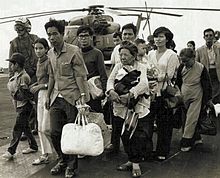
Escape of Vietnamese from the communist troops

Conquest of South Vietnam
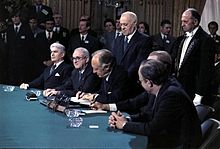
Signing of the Paris Agreement
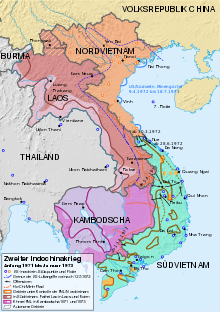
Map of development in Indochina 1971 to 1973

South Vietnam 1970 and the invasion of Cambodia
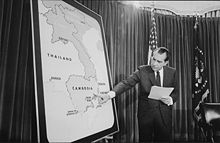
US President Richard Nixon announces attack on Cambodia on April 30, 1970
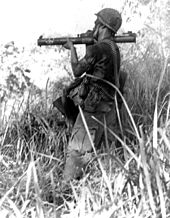
Soldier of the 101st U.S. Airborne Division in Vietnam
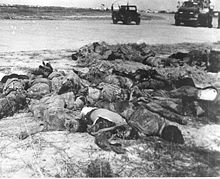
NLF fighters killed, Saigon, February 1968
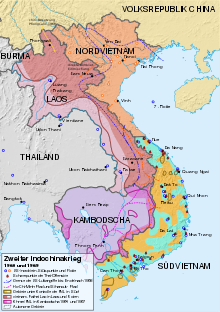
Development in Indochina after the Tet Offensive

NLF burning camp in Mỹ Tho, April 5, 1968.
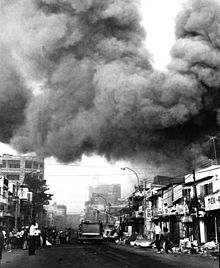
Saigon during the Tet Offensive 1968
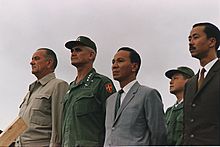
South Vietnam, October 26, 1966 (from left): Lyndon B. Johnson, William Westmoreland, Nguyễn Văn Thiệu, Nguyễn Cao Kỳ (far right).
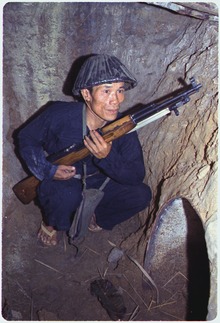
NLF fighter in 1968 in an earth bunker

Helicopter mission in Vietnam, 1966

Sprayed areas in South Vietnam; green: defoliation, red: crop destruction.
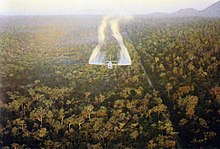
A UC-123B sprays Agent Orange (1962)
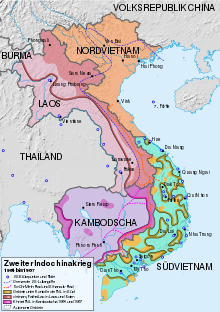
Situation in Indochina 1964 to 1967 with area of bombardments
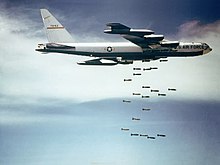
Boeing B-52 dropping a bomb
_1969,_MiNr_1476.jpg)
GDR surcharge stamp of the series Invincible Vietnam from 1969
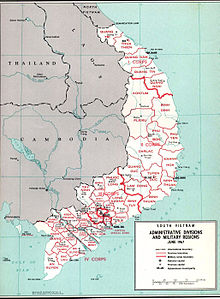
Map of South Vietnam made by CIA

U.S. President Johnson announcing the bombing of North Vietnam on August 4, 1964.

A "Zippo Monitor" of the Mobile Riverine Force bombards the shore with napalm
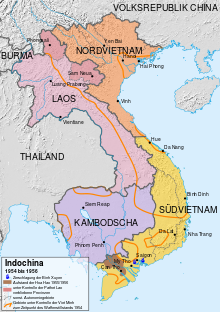
Indochina, 1954 and 1956
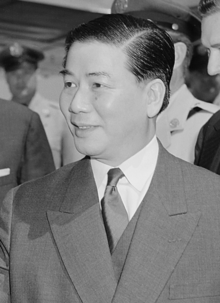
Ngô Đình Diệm on May 8, 1957
Balance
Dead and injured
The total number of Vietnamese killed by this war is estimated differently because the war period and war zones are determined differently, official records are missing, were kept secret or falsified, many victims were unidentifiable or untraceable, and people are still dying from war-related damage today.
Based on hospital statistics in South Vietnam, Guenter Lewy estimated in 1978 that 1.2 million Vietnamese civilians were killed by warfare from 1965 to 1974. A U.S. Senate committee at the time estimated these casualties at 1.4 million. Rudolph J. Rummel estimates that 1,747,000 Vietnamese were killed in the war from 1960 to 1975. To these must be added Vietnamese, Laotian, and Cambodian victims of the democides that occurred before, during, and after that war. Marc Frey estimated 2.3 million Vietnamese killed in the war from 1961 to 1975. Total estimates range up to four million, about one-eighth of Vietnam's total population, including 2.6 million South Vietnamese and 1.1 million NVA and NLF combatants. In contrast, U.S. citizens interviewed during the U.S. war effort believed there were only about 100,000 Vietnamese war casualties.
North Vietnam did not publish casualty figures during the war, or published figures that were far too low, in order to avoid demoralization or uprisings among its own population. On April 3, 1995, Vietnam announced that from 1954 to 1975, two million each of North and South Vietnamese civilians (12-13% of the total population) and 1.1 million NVA soldiers and NLF fighters had died in the war. 600,000 soldiers had been wounded. In addition, explosive devices used in the war, such as land mines, killed over 42,000 and injured over 62,000 Vietnamese from 1975 to 2011, according to Vietnam. Damage caused by Agent Orange killed another 400,000 Vietnamese by 2009.
According to the study, about four times as many civilians died in the Vietnam War as soldiers. The causes are considered to be the highly technical warfare, massive area bombardments and artillery fire in populated areas, indiscriminate killing in free-fire zones, the equation of peasants and guerrilla fighters, and the use of chemical warfare agents at a distance.
The U.S. military recorded exactly 58,220 U.S. soldiers killed in Vietnam since June 8, 1956. 55,661 of these died in South Vietnam, 40,934 in combat, with particularly high numbers in 1967 (11,100), 1968 (16,600), and 1969 (11,600). 38,000 were in the Army, about 14,000 in the Marines. 49,380 were white, 7,243 African American. 48,717 were enlisted men, 7,881 officers. More than half were 21 or younger, 18 of whom had not yet reached their 18th birthday. The youngest casualty was a 15-year-old Marine who had given a false date of birth when he enlisted. Friendly fire accounted for 18% of the deaths. 153,303 U.S. soldiers were wounded. Troops allied with the U.S. and South Vietnam lost a combined 5,264 soldiers, over 4,000 of them from South Korea.
Consequential damage
The war-related population structure, social upheaval, devastation, war injuries, trauma and secondary diseases burden millions of Vietnamese and shorten their life expectancy. At the end of the war in 1975, South Vietnam had one million war widows, 875,000 orphans, 200,000 disabled people and 200,000 prostitutes. In addition, there were the consequences of internal displacement and waves of refugees. In Laos, as many as 700,000 people, 40% of them members of the Meos, fled U.S. Air Force bombing raids between 1960 and 1970. At least 40,000 died from fighting, and another 100,000 from hunger and disease during the war.
Scientists estimate that from 1965 to 1971, the U.S. Air Force dropped two to three times the amount of bomb munitions (up to seven million tons) on Vietnam as it did in all of World War II. They left an estimated 21 million bomb craters; some regions of Vietnam are so densely littered with them that they resemble a moonscape. An estimated 3.5 million land mines and about 300,000 tons of unexploded munitions of war remain in Vietnam's soil.
Dioxin-containing herbicides, especially Agent Orange, caused long-term environmental damage. The amount sprayed was equivalent to 400 kg of pure dioxin. It affected an estimated 3.3 million hectares of forest, contaminated 3,000 Vietnamese villages, and permanently poisoned an estimated 24,000 square kilometers. This seventh of South Vietnam's total land area includes a much higher percentage of once fertile lands and forests. In addition, 1,200 square miles (about 3,000 square kilometers) of South Vietnam were leveled with bulldozers. In 2007, one million adults and 150,000 children in Vietnam suffered from cancers, psychological and genetic damage. Because dioxins and genetic damage are persistent, they will affect more generations.
In February 1965, U.S. manufacturers had agreed to keep secret from the U.S. government that their dioxin-contaminated herbicides severely damaged internal organs. In the fall of 1969, a study proved that Agent Orange caused damage to genetic material, malformed fetuses and miscarriages. In 1970, it was initially banned in the USA. Beginning in 1978, Vietnam veterans suffering from cancer filed the first class-action lawsuits against Monsanto, joined by company workers. Studies commissioned by Monsanto, which denied a link between contamination with its products and cancer among the plaintiffs, proved to be methodologically falsified in 1986. In 1991, therefore, the U.S. Congress passed a law classifying U.S. war veterans suffering from Agent Orange-attributable illnesses as war wounded. This made it easier for them to receive compensation payments. Gradually, the Department of Veterans Affairs recognized 14 diseases that could be caused by defoliants, including Parkinson's disease, multiple myeloma, type 2 diabetes, heart failure and prostate cancer. Lawsuits by U.S. Navy soldiers then deployed on the open seas to be treated the same as soldiers deployed domestically with regard to exposure to herbicides are ongoing.
Over 40,000 U.S. soldiers became addicted to heroin in Vietnam by 1970. 330,000 returnees were unemployed by the end of 1971. Over 300,000 veterans, out of two million by then, were delinquent and incarcerated by the end of 1972. Beginning in 1969, it gradually became known that hundreds of thousands of Vietnam veterans had suffered undiagnosed and untreated traumas. These caused a particular post-traumatic stress disorder (PTSD). By 1982, a year-long scientific study found: 478,000 (15.2%) of 3.14 million veterans suffered full PTSD, and another 350,000 (11.1%) suffered partial PTSD. Among African Americans (20.6%), Hispanics (27.9%), and those disabled by war injuries, the percentages were even higher. Only a small fraction had sought medical treatment for it. As a result, the U.S. Congress became more willing to fund special treatment centers and programs for Vietnam veterans.
Costs
In 1966, the U.S. government spent twice as much on the Vietnam War as on social reform programs. By 1968, the cost of the war had risen to $80.5 billion ($590 billion in today's dollars), causing inflation to rise from 2.7% to 4%. In March 1968, there was a crisis in the gold market. As a result, business elites in the U.S. also called for an early end to the war.
The U.S. Army recorded 8,612 destroyed aircraft and 4,868 destroyed helicopters valued at about $12 billion. Munitions consumed cost $37 billion to $42 billion. The Army's average oil and gas consumption of one million barrels per day contributed to the 1973 oil crisis. James Donovan estimated the U.S. war cost, including maintenance costs of allied armies, at $108.5 billion. According to Anthony S. Campagna, the U.S. war effort cost its defense budget about $173 billion ($820 billion in today's dollars). Indirect and subsequent costs, such as for the maintenance of allied troops, economic aid to their states, compensation for war-injured U.S. veterans, interest on war loans, and tax costs of conscription and tax losses from war deaths, he estimated at an additional $332 billion (today's value $1,574 billion). He added that this figure did not take into account the burden on the national budget from war-related inflation and declines in exports.
To this day, the U.S. refuses to pay Vietnam reparations or other compensation. Instead, Vietnam's government had to assume the debts of the former South Vietnam in 1993 in order to obtain loans and have a U.S. embargo lifted. In 2007, the U.S. approved $400,000 for the first time to clean up dioxin residues in Danang. In May 2009, U.S. President Barack Obama doubled that aid from $3 million to $6 million. However, compensation claims by Vietnamese with cancer were rejected by U.S. courts.
War Crimes
As a result of the Tet Offensive, General Westmoreland temporarily lifted U.S. Army protection rules for civilians in February 1968, allowing troop leaders to attack sites of contested regions without consultation and with weapons and units of their choice. Task Force Barker had lost about 20% of its men in its operations and had few body counts to show for it. Its officer, Ernest Medina, instructed his soldiers on March 15 to also treat women and children of their search area as enemies, inviting them to murder. On March 16, 1968, at least 22 U.S. soldiers murdered 504 people, mostly women, children, and the elderly, in the My Lai massacre, adding these casualties to the NLF fighters they killed. Helicopter pilot Hugh Thompson, Jr. prevented further killings and evacuated some villagers. It was not until a year later that uninvolved witness Ron Ridenhour obtained an internal investigation. None of the few survivors were heard as witnesses. On December 5, 1969, a report by Seymour Hersh brought the massacre to worldwide attention. Lieutenant William Calley, the lead officer, was sentenced to life in prison for it in 1971. After an appeal, the sentence was reduced to three and a half years. In November 1974, Secretary of the Army Howard H. Callaway released him from the remainder of his sentence.
The U.S. government portrayed the crime as an isolated isolated act in order to avoid having to withdraw its troops earlier. Up to 150 Vietnam veterans, including John Kerry, who were actively and passively involved, testified at two conferences ("Winter Soldier Investigation," December 1970, January/February 1971) that similar crimes had occurred daily. In My Lai, he said, only a particularly large number of villagers had been killed at one time. Officers had subtly but effectively instructed new U.S. soldiers in the systematic murder of civilians and prisoners. Today, a memorial and memorial site commemorates these crimes.
In 2003, the Toledo Blade magazine publicized war crimes committed by the Tiger Force. In 1967, during forced relocations (Strategic Hamlet Program) in the provinces of Quảng Ngãi and Quảng Nam, the Tiger Force committed numerous mass murders for seven months while combing through destroyed villages. The U.S. Army investigated 18 alleged perpetrators from 1971 to 1975, but did not bring them to justice. In 2003, three of the perpetrators publicly stated that they had only carried out orders. Such acts of murder had been common among all U.S. ground forces, especially in free-fire zones where civilians were considered fair game. U.S. military records list such crimes by hundreds of combat units. The U.S. military supreme court prosecuted only 36 of these cases and convicted 20 perpetrators. Causes of the crimes are believed to be frustration with the guerrilla war and the body count on which promotions depended. According to Guenter Lewy, U.S. officers rarely reported murders of their soldiers, but noted them as shootings of fugitive Viet Cong fighters to increase the killing tally.
Deborah Nelson ("The War behind me," 2008) found hundreds of routine file notes in the National Archives on war crimes in Vietnam similar to that of My Lai. These included every major U.S. Army unit and all major counterinsurgency operations in Vietnam that were conducted amidst civilian populations. U.S. military courts had investigated the crimes internally after Nixon demanded in 1969 that the U.S. Army disappear from the front pages of the press. Anonymous letters from U.S. soldiers to superiors included statements such as "one My Lai every month for over a year." For example, U.S. soldiers made villagers walk ahead through mined terrain, tortured prisoners with waterboarding and electric shocks, and shot teenagers and children for no reason. The exact number of perpetrators and acts is unknown. Twenty-three perpetrators were convicted; most were acquitted. One soldier who raped a 13-year-old girl as an interrogator in a POW camp was sentenced to 20 years of hard labor but was released after 7½ months. The U.S. Army pointed out its internal procedures to journalists, who usually stopped further research. As a result, these crimes remained widely unknown. In the U.S., My Lai is therefore mistakenly considered an exceptional case to this day.
The ARVN often broke the Geneva Conventions protecting prisoners of war with beatings and torture.
In addition, at least 48 massacres by South Korean soldiers in villages in South Vietnam have been documented, five of them in Binh Dinh province. Examples include the massacres in Phong-Nhi and Bình Hòa.
North Vietnamese and NLF members also often murdered civilians in South Vietnam who were considered collaborators and prisoners of their opponents. The Vien Cau (1964), Dong Xoai (1965), Long Binh (400 dead), Son Tra (1968) and Phu Thuan (1970) massacres are well known. In the Dak Son massacre (December 5, 1967), NLF fighters killed 252 civilians and abducted about 1,700 of 2,000 villagers. In the Hué massacre during the 1968 Tet Offensive, they killed up to 5,000 people, including children.
Approximately 760 U.S. soldiers became prisoners of war of North Vietnam or the NLF between 1954 and 1973. North Vietnam used the former French Hỏa-Lò Prison in Hanoi ("Hanoi Hilton") for downed U.S. pilots and attempted to force them to testify against the U.S. mission through torture and solitary confinement. In July 1965, the NLF publicly executed three prisoners in retaliation for executions of NLF prisoners by Diem's regime. In response, the United States urged Diem to halt them. In October 1965, the IRC condemned all violations of the Geneva Convention in Vietnam and admonished the Diem regime to protect the lives of South Vietnamese POWs as well as U.S. soldiers. The NLF released two U.S. soldiers after they publicly opposed the U.S. mission. In June 1966, U.S. POWs were forced to march for hours through Hanoi's streets in retaliation for U.S. airstrikes on Hanoi; they were mistreated by city residents. Soldiers, however, protected their lives. The U.S. government asked the Soviet Union, Poland, India, Sweden, and the Vatican to make diplomatic protests against the treatment of these prisoners. At the same time, U.S. senators threatened North Vietnam with massive retaliation. Ho then backed away from further show trials of captured U.S. soldiers. After his death in 1969, or after the failed prisoner release from the Sơn Tây POW camp by a U.S. commando on November 21, 1971 (Operation Kingpin), North Vietnam completely stopped torturing U.S. POWs. These were concentrated in the "Hanoi Hilton" at that time.

US reconnaissance photo of Sơn Tây prison camp near Hanoi.
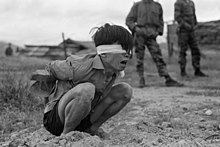
Torture of captured NLF fighters
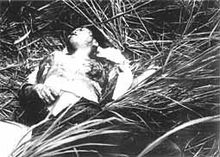
Vietnamese woman murdered by South Koreans with her breasts cut off, Phong Nhi massacre, February 12, 1968.

Play media file Video from Operation Baker, 1967
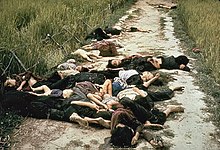
My Lai murder victim

U.S. Fairchild UC-123B spray Agent Orange
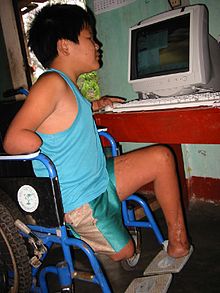
Landmine victims in Vietnam
.jpg)
The German hospital ship Helgoland cared for primarily civilian casualties in Vietnam from 1967 to 1972.
Political effects
War opposition in the USA
The U.S. government kept the activities of military advisors secret and hardly informed citizens about the extent, goals and effects of its war effort in Vietnam. It was not until 1965 that this was widely discussed in the United States. Western reporters were able to observe war events relatively unmolested and report on them with the usual military restrictions. In 1965, 400 U.S. journalists were accredited in South Vietnam and allowed to participate in U.S. combat operations. In 1968, their number increased to 650. However, according to MACV, only 35% of these accompanied combat troops to the front lines, and only about 10% of 4100 reports showed combat. None of the senior U.S. journalists thought the war was wrong, but at most criticized "tactical" problems with the ARVN from the perspective of their own military. The latter approved of frequent censorship measures by the ARVN. Most television reports stayed in line with the U.S. government. Atrocities were not shown until the Tet Offensive. The first "television war" in history occupied about 20 to 25% of the evening news in the United States from 1968 to 1973. Many battle scenes in the mostly three- to four-minute reports were posed after the fact and focused on individual exploits. In contrast, war crimes, lust for killing, wearing body parts of killed enemies as trophies, drug problems, and disciplinary deterioration among U.S. soldiers were not reported. The U.S. media reported on killed U.S. soldiers four times more frequently than on killed Vietnamese during prime time.
Among the earliest critics of the Vietnam War, since 1954, was Isidor Feinstein Stone, who predicted in 1963 after Diem's fall: the U.S. would lose its war for South Vietnam. Walter Lippmann had also been an opponent of the war since 1964. Reports of the Tet Offensive contributed to the change of opinion in the United States. The execution of NLF prisoner Nguyễn Văn Lém by Saigon police chief Nguyễn Ngọc Loan on camera and the photograph of nine-year-old girl Kim Phuc running naked, badly burned, and screaming past U.S. soldiers from her burning village after a napalm attack became world famous. Walter Cronkite interviewed U.S. soldiers in February during the fighting in Hue and commented, "The war has reached a hopeless impasse and cannot be won. Negotiations with North Vietnam were the only realistic alternative.
In regular nationwide Gallup polls on whether the U.S. war effort had been a "mistake," 61% answered no (1965), 50% (1966), 44% (1967), 34% (1968), 24% (1971). Accordingly, most U.S. citizens thought the war effort was right only in the first year. As it lasted and casualties increased, this percentage steadily declined. However, in 1967, only 6% favored an immediate exit, while 80% favored an escalation to hasten the end of the war. It was not until the end of 1968 that a majority said yes to withdrawal, and not until the end of 1970 that they said yes to the immediate withdrawal of U.S. troops.
The implausible reason for the war, the continued bombing of North Vietnam without a declaration of war, the information policy of the U.S. government, the use of chemical weapons, the body counts, war crimes and others deprived the war of any moral justification for many. From older groups of the movement against nuclear weapons and the civil rights movement of the 1950s, as well as the counterculture of the hippies ("make love not war"), the student movement and New Left of the 1960s, a peace movement emerged from the fall of 1964 that ranks among the largest protest movements in the United States. It tested new forms of civil disobedience for far-reaching emancipatory and anti-authoritarian goals of comprehensive social change. It consisted of a variety of different groups without an umbrella organization and, according to a CIA report requested by Johnson, was neither Communist-led nor influenced.
Between November 1964 and March 1965, four pacifists in the U.S. killed themselves by self-immolation in protest of the U.S. use of napalm. Beginning on March 24, 1965, Vietnam Days with teach-ins were held for months at more than 100 universities. Protests were also held against authoritarian structures in the education system. The first national anti-war demonstration on April 17, organized by Students for a Democratic Society (SDS) under Tom Hayden, was attended by about 20,000 people. The U.S. government sent "truth teams" of diplomats to colleges beginning May 15 during the bombing pause to promote its point of view. "Peace parades" in 80 U.S. cities on October 15 and 16, 1965, were already attended by about 100,000 people. Other large nationwide demonstrations against the Vietnam War took place on April 15, 1967 (New York City: 200,000; San Francisco: 50,000), October 16, 1967 (Washington DC: 50,000), October 15 (250,000), and November 15, 1969 (500,000). On October 21, 1967, about 5,000 of 50,000 demonstrators broke through the police cordon in front of the Pentagon and took the U.S. flag from the building. Resistance, mostly organized by SDS, was increasingly directed against the "military-industrial complex," military research, and financial support of universities by the Department of Defense. Violence against individuals occurred more frequently in actions against Dow Chemical and U.S. Army recruiting centers beginning in 1969. Across the country, thousands of citizens' initiatives organized against conscription and for neighborhood work, which they offered as an alternative social peace service. Leading figures of the New Left founded the umbrella organization National Citizens for a New Policy (NCNP) for this purpose. At a conference in the summer of 1967, they did not find a common line for the 1968 election year; it remained controversial whether to refuse to vote, to form an alternative antiwar party, or to field prominent opponents of the war as independent countercandidates.
Some activists, such as Jane Fonda and Joan Baez, traveled to North Vietnam to see war damage and show a "different America." Large segments of the U.S. population saw these war opponents as traitors; counter-demonstrations and physical attacks ensued. Among the opponents of the war, radical leftists who saw the NLF as an anti-colonial liberation movement clashed with liberal Democrats who supported Johnson's social policies and wanted to bring U.S. soldiers home. A strong current in the antiwar movement was Christian pacifism, represented by Abraham John Muste, Daniel and Philip Berrigan, for example.
Martin Luther King, leader of the civil rights movement, had been advocating negotiations with the NLF since March 1965. On April 4, 1967, in his strongest sermon to date, he sided completely with the war opponents and became their spokesman. The Vietnam War and poverty in the U.S. remained major themes of his speeches until April 4, 1968, when he was assassinated. Jesus Christ's commandment to love one's enemies also applied to communists. Since 1945, he said, the U.S. had prevented Vietnam's national self-determination, propped up corrupt dictators, crammed villagers into concentration camps, poisoned their soil and forests, and killed at least 20 civilians for every Viet Cong killed. He said the U.S. government must immediately stop the bombing, give a withdrawal date for U.S. troops, and allow the NLF to participate in any future government of Vietnam.
During the Vietnam War, opposition to conscription in the United States grew to an all-time high. Some 600,000 violations of the 1948 law requiring conscription of all men between 18 and 26 were recorded from 1964 to 1973. 210,000 of these (up to 10% of all criminal cases in the U.S. at the time) were prosecuted. Tens of thousands evaded the draft through conscientious objection, desertion, and civil disobedience such as publicly burning or returning draft cards. The U.S. government increased the legal penalty for such actions to up to five years in prison and heavy fines beginning in August 1965. Between 30,000 and 50,000 draftees fled to Canada or Sweden. Because of the "baby boom" of the 1950s, this did not jeopardize U.S. Army recruitment and manpower levels. However, members of the lower social classes were disproportionately drafted. Johnson lifted the deferment for full-time students in June 1966, causing a substantial increase in the number of conscientious objectors. After Nixon replaced universal conscription with a lottery system in 1969, it declined again. Poor African Americans initially often volunteered for the U.S. Army, from which they hoped for career and social advancement. In the wake of the 1966 Black Power movement, which saw the same racism at work against oppressed people of color in the Vietnam War and civil rights struggle, this tendency declined significantly.
In the U.S. Army, opposition to the war gradually increased. Some U.S. soldiers in Vietnam refused orders, produced and secretly distributed antiwar pamphlets, attacked superiors, and shot some. The U.S. government no longer dared to use military personnel in an antiwar demonstration, fearing their solidarity with the protesters. In November 1967, the Vietnam Veterans Against the War group formed and grew rapidly in 1970. On April 23, 1971, about 700 members threw their medals and medal ribbons on the steps of the Capitol Building. Twenty to 25% of the U.S. soldiers involved thought the Vietnam War was wrong.
FBI Director J. Edgar Hoover had antiwar actions at universities under surveillance since April 1965, infiltrating agents into action groups, creating lists of suspected individuals (mostly SDS members), and having the FBI work with university watchdogs. Beginning in April 1966, the FBI shared its surveillance reports with intelligence agencies and the military, and regularly with the White House beginning in March 1968. As a result of these reports, Attorney General Ramsey Clark indicted five activists in January 1968 for conspiring to violate the conscription laws. All 28,000 signers of a petition against it and reporters about it were considered accomplices, according to the indictment. On May 9, the FBI began the secret COINTELPRO campaign to obstruct, neutralize, or stop activities of antiwar groups. The FBI linked the campaign to three CIA surveillance programs (Operation CHAOS, Project MERRIMAC, and Project RESISTANCE) and an NSA telephone and wire surveillance program (MINARET). By 1974, this had resulted in the creation of files on at least 23,500 individuals. In thousands of cases, telephones were tapped and letters opened. The U.S. Army received requested information on individuals under surveillance, in turn used 1,500 civilian agents to monitor war opponents by 1971, and created index cards of over 100,000 civilian protesters and 760,000 individual or group activities. These programs were exposed by a Senate hearing in 1971 and then officially terminated.
The antiwar movement significantly influenced the presidential elections of 1968 and 1972. While the RepublicanParty united in support of the war, the Democratic Party split into "hawks" and "doves." Beginning in December 1967, Democratic Senator Eugene McCarthy ran against Johnson's reelection as an opponent of the war. After his success in the New Hampshire primary on March 12, 1968, Robert F. Kennedy, who had become an opponent of the war since 1965, also sought his party's nomination. Partly for this reason, Johnson decided on March 31 not to run for a second term. On April 4, Kennedy announced the fatal assassination of King at a campaign appearance and prevented local turmoil with a conciliatory speech. He was therefore considered a promising candidate with majority support until he too was assassinated on June 5, 1968. The antiwar movement then tried in vain to prevent the nomination of Vice President Hubert Humphrey as presidential candidate at the Democratic convention in August. A sit-in by some 10,000 anti-war activists was violently dispersed by strong police and military forces while it was being televised. This deepened the split among the Democrats and greatly increased Richard Nixon's election chances. The latter promised "peace with honor" in Vietnam, "law and order at home," and claimed to have a secret plan to pacify Vietnam. Only when Johnson stopped bombing North Vietnam and offered Humphrey an early troop withdrawal for the Paris talks did the latter catch up in the polls. Nixon's narrow majority thus meant a voter mandate to end the war. George McGovern became the Democratic presidential nominee in 1972 among 12 competitors because of his clear anti-war stance. But he, too, lost to Nixon because only part of the Democrats supported his course.
For many U.S. citizens, Nixon broke his campaign promise to Vietnamize and end the war with the new U.S. attacks on Cambodia. Nixon's attempt to send another 200,000 U.S. troops to Indochina, invoking the Tonkin Resolution, provoked opposition in the U.S. Congress. Senator William Fulbright regretted his earlier war involvement and pushed through a commission of inquiry into the Tonkin Incident. This determined on April 11, 1970, that there had most likely been no attack by North Vietnam in 1964. As a result, the U.S. Senate and House of Representatives successively withdrew the resolution.
The nationwide antiwar movement, which had already suspended its actions, called for new protests beginning in April 1970. On May 4, 28 U.S. National Guard soldiers shot and killed four protesters or bystanders on the grounds of Kent State University. This Kent State massacre caused the largest wave of protests in the U.S. to date: 1.5 to two million students (about 25%) went on strike. Now even union federations, which until then had unreservedly supported the war, distanced themselves from it. On May 8, 1970, 100,000 opponents of the war demonstrated in front of the White House. Nixon sought direct contact, but spoke only about sports. The U.S. Senate on June 30 prohibited Nixon from sending military advisers to Cambodia, from supporting Cambodian troops with U.S. Air Force or financially, even through other states. This forced him to accelerate the U.S. troop withdrawal. Because of the expansion of the war and the demonstrators killed, there were calls for impeachment against Nixon for the first time. After nationwide anti-war demonstrations with millions of participants, Nixon warned the "silent majority" of the U.S. on November 3: An immediate U.S. withdrawal would result in "bloodbaths" in Vietnam; not North Vietnam, only U.S. citizens could humiliate the United States. He subsequently received 70% approval in the poll for the known part of his policy, but not for a new military escalation.
In the summer of 1971, Daniel Ellsberg, a former advisor to McNamara, released the Pentagon Papers to the press. According to this secret report on U.S. Indochina policy since 1945, U.S. military experts had criticized support for the regime in South Vietnam even under Eisenhower, doubted the long-term prospects for success against the NLF, and warned that the Vietnam War could hardly be won militarily. No U.S. president had dared to publicly advocate these doubts and corresponding withdrawal plans. The papers also proved that the Pentagon had deliberately used the Tonkin incident as a rationale for war. The arrest of some burglars at the Democratic Party headquarters developed into the Watergate scandal. In the course of it, Nixon was finally exposed as having commissioned illegal surveillance of opposition politicians and war opponents such as Daniel Ellsberg. As a result, the U.S. Congress decided to impeach him. In 1974, Nixon resigned before his impeachment.
War opposition in other states
In Australia and New Zealand, strong protest movements against the Vietnam War emerged in 1967, pressing for the withdrawal of aid troops sent by their conservative governments from South Vietnam. In Great Britain, the majority of the government and the population were initially in favor of the U.S. war effort. Harold Wilson, however, evaded U.S. demands for military aid and made independent attempts at mediation along with the Soviet Union. In 1967, British protests against the war increased sharply. In December, demonstrators attempted to storm the U.S. Embassy in London. Beginning in 1968, conservative British media also moved away from the United States. The Paris talks softened protests but solidified widespread opposition to the war.
France opposed the U.S. war effort from the beginning. 70% of the French were against it in 1965. De Gaulle publicly advocated Vietnam's neutralization until France left NATO, most recently in Phnom Penh in 1966, and maintained correspondence with Ho. Hubert Humphrey's 1967 visit to Paris was marked by severe, sometimes violent protests. The Paris police crackdown on student Vietnam protests triggered the Paris May 1968, which nearly led to the fall of de Gaulle.
In May and November 1967, Bertrand Russell and Jean-Paul Sartre conducted the first Russell Tribunal in Stockholm and Copenhagen, which applied existing international law to the Vietnam War without an institutional mandate and questioned Vietnamese victims of bombing. Secretary of State Dean Rusk declined several invitations from the tribunal to testify. The latter condemned U.S. warfare in Vietnam as genocide.
For the West German student movement of the 1960s, the protest against the Vietnam War was central. It was directed against the uncritical support for the U.S. by the federal government, Bonn parties, and most of the media, which was seen as a characteristic of unresolved fascism in the country's own postwar society. In 1965, only 44% of West Germans saw the U.S. Vietnam War as a defense of freedom against communism. A committee for peace and disarmament and the SPD-affiliated SHB organized the first nationwide protests in the fall of 1965. Demands were made for Vietnam's self-determination under the 1954 Geneva Accords and for an end to all West German aid to the U.S. war effort, which was called "genocide." North Vietnam's revolutionary goals were not supported.
Since 1965, the West Berlin SDS was also concerned with Vietnam. In the summer of 1965, the AStA of the FU called for "Peace in Vietnam" and was voted out of office for this use of a political mandate. In response, 70 writers and 130 professors supported the "Declaration on the War in Vietnam" of December 1, 1965, which called for an open debate on the issue. On February 4, 1966, after German Chancellor Ludwig Erhard had unreservedly supported the Vietnam War during a visit to the U.S., a West Berlin group led by Rudi Dutschke used protest posters to warn of an escalation to nuclear war and called for a "take up arms" of targeted, provocative rule-breaking against it. The following day, demonstrators threw five eggs at West Berlin's Amerikahaus and took the U.S. flag from the building. This student anti-war action received nationwide media coverage for the first time. It was accompanied by an unprecedented deployment of nearly 20,000 police officers. During counter-protests by CDU supporters on February 8, students were beaten into the S-Bahn to Berlin-Ost without onlooking police intervening. The peaceful Easter marches in April were followed on May 22 in Frankfurt am Main by the congress "Vietnam - Analysis of an Example," organized by the SDS, with about 2,000 participants. In the run-up, it was disputed whether to call for an immediate ceasefire or to support a "victory of the Vietcong." The philosopher Herbert Marcuse declared in his well-received speech that a moral duty arose from the time of National Socialism to oppose the Vietnam War. Thus the SDS took the initiative in the anti-war campaign at the universities, for which it spent a large part of its funds. It understood the Vietnam War as a war of liberation of the Vietnamese against an aggressive U.S. imperialism and worldwide capitalism. Student protests were intended to help the NLF win. Anti-authoritarian protest methods were preferred and tested.
On November 28, 1966, demonstrators in Munich charged that the German government was helping a regime that needed six or seven Hitlers by sending poison gas experts and building concentration camps in South Vietnam. This referred to General Ky's statement of July 4, 1965: His only hero was Hitler, who had held his country together in terrible circumstances. Four or five Hitlers would be needed in Vietnam. On December 6, 1967, SDS supporters prevented South Vietnam's ambassador from speaking at an RCDS event. Police violence occurred at subsequent demonstrations on December 10 and 17. On Christmas Eve, Rudi Dutschke was beaten up by visitors to the Kaiser Wilhelm Memorial Church when he tried to discuss the Vietnam War during the service. During the Tet Offensive, demonstrations took place in many West German cities. On February 17, 1968, an International Vietnam Congress was held in West Berlin, proclaiming a "second revolutionary front" in the metropolises. Among other things, they wanted to practice sabotage against military installations important to the war effort, call on U.S. soldiers to desert, and seek the withdrawal of the Federal Republic from NATO. The following day, up to 20,000 people demonstrated against the Vietnam War. Dutschke was briefly dissuaded from leading the route past a U.S. barracks and storming it, as U.S. soldiers had orders to shoot. An International Intelligence and Research Institute (INFI) was established, dedicated to Vietnam intelligence. After the assassination of Dutschke in April 1968, anti-war protests subsided and other issues came to the fore.
An August/October 1966 Gallup poll found (figures in %):
| Position | USA | GB | F | FRG |
| Begin troop withdrawal | 18 | 42 | 68 | 51 |
| Maintain current status | 18 | 17 | 8 | 19 |
| Amplify attacks | 55 | 16 | 5 | 15 |
| No opinion | 9 | 25 | 19 | 15 |
Postwar policy of Vietnam
On July 2, 1976, North and South Vietnam were reunited under the name Socialist Republic of Vietnam. Saigon, temporarily the capital of the constituent state of South Vietnam, was renamed Ho Chi Minh City (Thành phố Hồ Chí Minh).
The country was thus reunified and sovereign as a whole, as Ho had aspired to throughout his life. The NLF was dissolved in 1977.
North Vietnamese killed about 60,000 "undesirable" South Vietnamese since 1975, interned hundreds of thousands of supporters of the Thieu regime in forced labor camps, and subjected them to an intensive political re-education program; some were tortured. By 1978 most, and by 1995 all, political prisoners were released.
Beginning in March 1978, the government nationalized important sectors of the economy and transferred private agricultural enterprises to cooperatives in order to distance itself from the opening of the People's Republic of China to capitalism and to contain the growing influence of successful entrepreneurs. That is why some 1.5 million Vietnamese, mostly of Chinese descent, fled Vietnam by boat across the Pacific; many of these "boat people" drowned. Those who reached Hong Kong often spent many years in refugee camps or were deported back to Vietnam. Over 100,000 emigrated to the United States, where they form a relatively impoverished fringe group.
With the capture of Cambodia's capital Phnom Penh on April 17, 1975, the Khmer Rouge began their years-long reign of violence. They murdered over two million Cambodians by 1978, which is now classified as genocide or democide. Because of frequent border incursions and refugee flows from the neighboring country, Vietnam allowed its forces to invade Cambodia in December 1978, where they overthrew the Khmer Rouge. In response, the People's Republic of China invaded border areas with Vietnam in February 1979 and temporarily occupied some of its islands, where large oil deposits were believed to exist. The Khmer Rouge waged a guerrilla war against Vietnam's troops until a cease-fire in 1991, which placed an additional economic burden on the country. Beginning in 1986, the government did allow partial privatization of agriculture under the Đổimới and increased its economic growth. However, the majority of Vietnam's 80 million people remained relatively poor for a long time.
Postwar policy of the USA
The U.S. Congress refused funds for Vietnam's reconstruction in 1973. U.S. President Gerald Ford, in defiance of Nixon's promises of aid, imposed an economic embargo on Vietnam that remained in effect until 1994. After the Khmer Rouge seized government power in Cambodia (April 1975), the Pathet Lao in Laos (December 1975), communists ruled three states in Indochina. Most U.S. citizens, however, opposed a resumption of the war. Ford took this attitude into account in May 1975, saying that the United States could regain its former pride, but not through a new war that was over as far as the United States was concerned. He prevented Vietnam's admission to the UN in 1976. His successor, Jimmy Carter, held firm in order to avoid feared resistance in the U.S. Congress and to obtain its approval for full diplomatic recognition of the People's Republic of China.
U.S. President Ronald Reagan put Vietnam under intense pressure over the issue of missing U.S. soldiers beginning in 1983 and persisted even after Vietnam offered unlimited cooperation from its authorities in the search in 1985. His successor, George H. W. Bush, blocked IMF loans that France wanted to arrange for Vietnam. Only U.S. President Bill Clinton allowed such IMF loans in 1993. In 1995, veterans from both countries strengthened their contacts and promoted veteran tourism to Vietnam. In 1997, the two countries opened embassies in Washington and Hanoi and agreed on a program by which Vietnamese officers trained U.S. soldiers in jungle warfare. Since then, economic relations between the two countries have also intensified.
The Vietnam War caused a lasting aversion among most U.S. citizens to further U.S. military interventions. As early as 1966, the U.S. government avoided providing more aid to Thailand so as not to be drawn into its internal conflicts. For the same reason, the U.S. Congress ended a CIA covert operation in the civil war in Angola in December 1975. Opponents of such actions coined the slogan "No more Vietnams!" Supporters labeled this attitude the "Vietnam syndrome" from 1978 onward, thus devaluing it as an abnormal, pathological condition that needed to be overcome in order to "win" the Cold War.
The Vietnam War had delayed U.S. rapprochement with the People's Republic of China and strengthened its ties with many right-wing dictatorships in Latin America. Thereafter, the U.S. had to pay domestic and foreign policy heed to its loss of international prestige. Only after the failure of the Iran hostage crisis in 1979 did U.S. interventions regain majorities of the U.S. population. Ronald Reagan declared in his 1980 presidential campaign that the Vietnam War had been fought for a "noble cause". Never again should U.S. soldiers be sent to war if the government was afraid to let them win. He allowed military intervention in Grenada and support for anti-communist civil war parties in Nicaragua and El Salvador, but ended the U.S. military presence in Lebanon in 1982 immediately after a bombing of U.S. soldiers. The Vietnam Veterans Memorial in Washington, built in 1982, came about without government contribution through private donations.
In 1985, Nixon wrote: Since the fall of Saigon, a key battle in the "Third World War" (meaning proxy wars of the superpowers in the Third World since 1945), the new isolationism in the U.S. had contributed to the fall of further "dominoes" (Laos, Cambodia, Mozambique, Angola, Ethiopia, South Yemen, Nicaragua) to Soviet communism. Only Reagan had stopped this series of U.S. defeats. But the "spirit of Vietnam" drives congressional debates about intervention in El Salvador and aid to the Contras in Nicaragua, he said. "We must purge ourselves of the debilitating disease of the Vietnam syndrome to avoid further defeats in World War III."
Prior to the 1991 Gulf War, the U.S. government obtained U.S. congressional approval and a U.N. mandate, formed a broad military war coalition, sent far superior troop numbers, gave it a clearly defined target, and censored news coverage. The rapid and "overwhelming" U.S. victory was seen as a successful overcoming of the national "Vietnam trauma." Then U.S. President George H. W. Bush believed that the "Vietnam syndrome" had finally been eliminated. However, after the Iraq War and increasing casualties and costs of the occupation of Iraq since 2003, Vietnam comparisons resurfaced in the US.
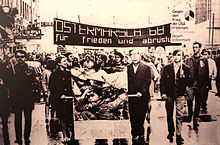
Anti-war demonstration in Vienna, 1968
.jpg)
Anti-war demonstration in West Berlin, 1968
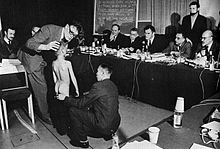
Russell Tribunal, Stockholm 1967
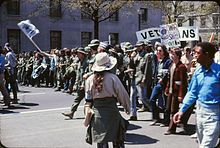
Veterans march against the war, April 1971

Martin Luther King, speech against the Vietnam War, St. Paul/Minnesota
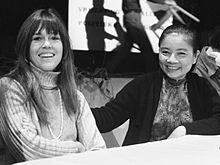
Jane Fonda with Phan Thi Minh, 1975
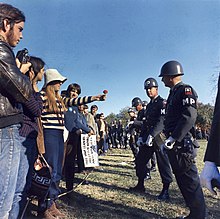
Demonstration in the USA against the war

Anti-war demonstration, Washington DC, 1967

Boat refugee from Vietnam in a refugee camp in Malaysia 1980

Vietnam Veterans Memorial in Washington, D.C.
Questions and Answers
Q: What was the Vietnam War also known as?
A: The Vietnam War was also known as the Second Indochina War or American War in Vietnam.
Q: How long did the war last?
A: The war lasted from 1 November 1955 to 30 April 1975, for a total of 19 years, 5 months, 4 weeks, and 1 day.
Q: Who were North and South Vietnam supported by?
A: North Vietnam was supported by the Soviet Union, China, and North Korea; South Vietnam was supported by the United States, South Korea, Thailand, Australia, New Zealand, and the Philippines.
Q: Who fought against South Vietnamese anticommunist forces?
A: The Viet Cong (also known as the National Liberation Front or NLF) fought a guerrilla war against South Vietnamese anticommunist forces.
Q: What type of warfare did the People's Army of Vietnam engage in?
A: The People's Army of Vietnam (also known as the North Vietnamese Army) engaged in more conventional warfare by at times putting large forces to battle.
Q: How did this conflict relate to Cold War tensions?
A: The conflict between communist and capitalist countries was part of the Cold War.
Q: Why did President Richard Nixon eventually agree to send American soldiers home in 1973? A: The war became so unpopular in the United States that President Richard Nixon eventually agreed to send American soldiers home in 1973.
Search within the encyclopedia